Wireless carrier T-Mobile says the personal information of a small number of individuals was exposed in a recent data breach.
The post T-Mobile Says Personal Information Stolen in New Data Breach appeared first on SecurityWeek.
Wireless carrier T-Mobile says the personal information of a small number of individuals was exposed in a recent data breach.
The post T-Mobile Says Personal Information Stolen in New Data Breach appeared first on SecurityWeek.

A brand new AMD Ryzen 7000 Direct-Die Water-Block has been released by Der8auer which offers up to 28C lower temps versus 280mm AIO.
Der8auer, the well-known overclocker, enthusiast & YouTuber from Germany is designing a new AMD Ryzen 7000 water block that rests directly on the die named the "AM5 Mycro Direct Die cooler," producing optimal thermal performance results compared to all-in-one (AIO) liquid coolers. The overclocking specialist tested the new direct die cooler on an AMD Ryzen 9 7900X CPU that was stressed to 90° C and tests show that it lowered the temperature to 65° C.
This new cooling solution from Der8auer will require users to remove the AMD Ryzen IHS which is otherwise known as the Integrated Heat Spreader so that the direct die block can achieve optimal contact with the processor and allow for the best thermal control.
The Der8auer Mycro Direct Die Water Block works with the high-performance heat spreader, also designed by Der8auer, which is used in place of the original mounting piece that comes with the AM5 socket to offer optimal control of the direct die block. The heat spreader makes direct contact with the trio (or duo in some cases) of chiplets featured on the AMD Ryzen 7000 CPUs.
The direct die cooling block is manufactured in acrylic and offers RGB & Non-RB lighting choices. At the same time, the separate heat spreader is built using a mirror-like diamond-milled precision surface. This will provide a superior surface for the processor to eliminate bending. These are only available for AMD's Ryzen 7000 CPUs.
In the above video from Der8auer, he demonstrates the design of the direct die water block and the heat spreader with AMD's Ryzen 9 7900X CPU, which he overclocked to 5 GHz with a voltage of 1.3 V. Several other coolers were tested to show the usefulness of his new product design, including a comparison with a typical 280mm AIO liquid cooler option.
The Mycro Direct Die cooling block demonstration from Der8auer was paired against a 280 mm liquid cooler. It offered much better cooling versus the other solutions on the AMD Ryzen 7000 CPUs, with the former receiving a 28-degree reduction (in Celsius) compared to the stock liquid cooling solution.
The Mycro Direct Die cooling solution is not available yet but will release soon for close to €140 for the RGB variant and €100 for the non-RGB style. To find access before anyone else, check out the creator's Patreon channel here & follow his YouTube channel for more information & overclocking tips, and insights.
Read more of this story at Slashdot.
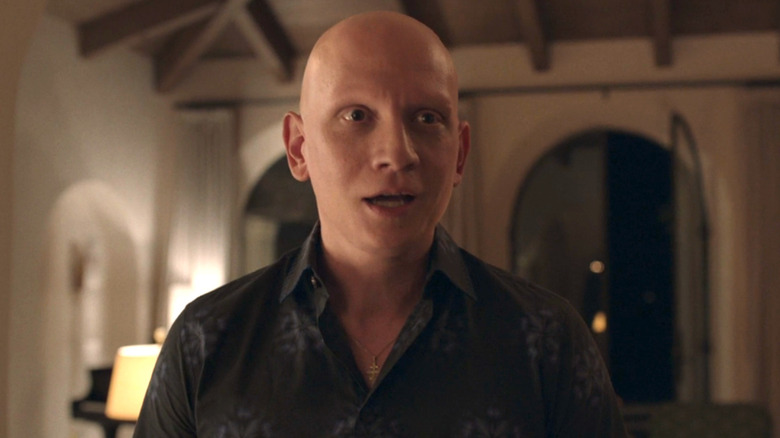
This article contains spoilers for "Barry."
As an audience, sometimes it's easy to forget that we're not the only ones that experience the emotional impact of the twists and turns that occur in our favorite shows. Throughout its entire run, HBO's "Barry" has been filled with shocking displays of violence, unexpected treachery, and frightening bursts of rage. And this was supposed to be a comedy! No matter how attached we think we are to a particular character, the actor inhabiting that onscreen persona is more than likely going to have a much deeper connection to the person they're playing.
Reaching a true level of believability takes a great level of preparation, with the two schools of acting -- the Stanislavski method and the Meisner technique -- offering two totally different approaches to help performers get to a place of authenticity. The Stanislavski way relies more on the actor's own memory to wring out emotion, whereas Meisner teaches actors to use each other's energy in the moment to reach a genuine moment of truth. Both are effective, but Meisner gives the option to leave your emotions at the door instead of opening up old wounds time and time again.
Although he doesn't come from the Gene Cousineau method of acting, whatever technique Anthony Carrigan uses seems to be working. And his character NoHo Hank on "Barry" has just reached a frightening crossroads after his rival turned lover, Cristobal (Michael Irby), was killed during the shocking finale of season 4, episode 4 "It Takes a Psycho." For all of Carrigan's acting prowess, the actor simply wasn't prepared for the emotional toll the scene would have on him personally.
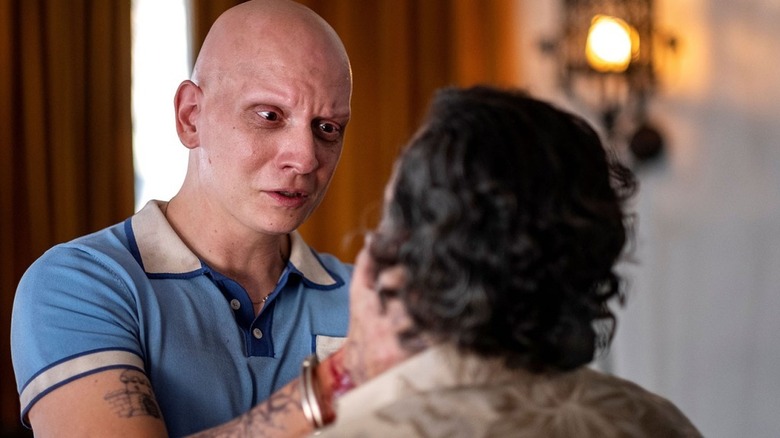
Reading the explosive and ultimately tragic scene for the first time took Carrigan by complete surprise. "When I initially read it, I had to take a beat. I was so devastated," Carrigan told BuzzFeed News. Gathering himself after the initial shock, Carrigan felt it was a little more on brand for Hank, saying:
"When I really thought about it and I unpacked it, it made total sense. They are in a life of crime, and there's no way to ever have a really gentle ending when you're surrounded by such danger."
For a good portion of the series, the audience has been impacted by the violence dished out by Barry Berkman (Bill Hader). Whether it's when he's moonlighting as an assassin or traumatizing his girlfriend Sally, Barry is the one who we're accustomed to watching go on the attack. Hank has always been the comic relief character who's been mostly content to survive in middle management for the Chechen crime syndicate. So naturally, It's unexpected for the viewer and for Carrigan himself when Hank flips the switch and lashes out.
"Hank has been a gentle person who just happens to be a crime lord. I think it's really going to throw people off when they see Hank really step into that crime lord role and do something atrocious and brutal. Even I was surprised by that. I was surprised that he was able to commit such an atrocity behind Cristobal's back. But at the same time, I felt like it was justified."
After saving Cristobal in the finale of season 3, Hank and Cristobal could've been happy, potentially, making Hank's sinister turn all the more startling. But maybe his betrayal is justified, after all.
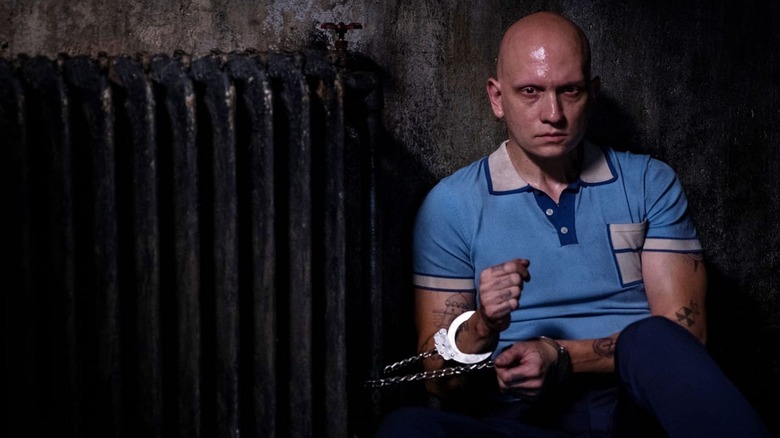
Deep down, Hank is really just scared to wind up back in that Bolivian jail cell chained to a radiator. And he'll do anything to make sure he never feels that weak again. Earlier in season 4, Hank suddenly finds himself transported back to that very cell, still trapped and helpless awaiting his imminent death. In a moment of intended confusion, at first it seems like his romantic interlude with Cristobal in New Mexico was all a dream and Hank had just been caught up in a hallucinatory death spiral. Maybe Hank's play to take out the Chechens in the silo (a move that almost kills Cristobal) stems from never wanting to be told he's helpless again, and more to the point, that he never feels helpless again for the rest of his life.
When Carrigan examined Hank's motivation from another angle, the move for power started to make more sense. "Once I connected the dots, I was like, 'Oh, of course Hank would do this,' Carrigan told Buzzfeed News. "He went from a place of being told that he was soft and being told that he wasn't capable of being menacing or intimidating. Hank just goes overboard with this act of violence, and it really does scare Cristobal."
Killing Cristobal was never part of the master plan, but looking back, it was inevitable. Unfortunately for Hank, his failed attempt to keep both of the safe tragically backfired, and now Hank is left locked inside a prison of his own making.
"Barry" airs on HBO and HBO Max on Sundays at 10 p.m. ET.
Read this next: The Best TV Shows Of 2022, Ranked
The post Why Barry Season 4 Episode 4 'Devastated' But Didn't Surprise Anthony Carrigan appeared first on /Film.
When I first encountered the Unix vi editor many years ago, I recoiled in horror. It was nothing like the editors I was used to—Borland IDEs, DOS 5.0/6.x EDIT, or OS/2 and Windows editors. But over the years, I learned to use vi.
It turns out that on many exotic *nix systems, vi is the only game in town. Sure, there might be some way to install pico or nano or whatever, but even if that is possible, it might be very difficult to get there without editing a couple of files… with vi. And when the system in question is some ancient XENIX or PC/IX or Microport UNIX or whatever, the effort of installing some other editor vastly outweighs the effort of learning vi—and that’s if the system in question even comes with a compiler.
Some time later I started using the vi editor that comes with the (Open) Watcom compilers. It’s a decent vi clone, not great but workable. It has the nice property that there are console versions for DOS, OS/2 (both 32-bit and 16-bit), and NT available (and *nix, too). The DOS version that ships with the compiler is a 32-bit DOS-extended version, but it’s also possible to build a 16-bit version. Which will run on a 286 or even an 8086, and that’s occasionally useful.

I’ve been using the 16-bit DOS version of Open Watcom vi for some time, and it works well… except sometimes it hangs the system. But only sometimes and not very consistently. When it does hang, it usually happens when quitting the editor, but rarely also when starting it up.
I’ve never been able to track down the problem because it doesn’t happen frequently enough and when it does, all I can see that the system ends up in a corrupted state. Until yesterday.
Somehow I ended up in a situation where running vi immediately after starting a certain DOS VM would trigger the hang, maybe 80% of the time. I decided to pounce. Once again, I couldn’t tell much from the hung state. So I decided to roll out the big gun. I ran the VirtualBox VM in a debug build with software instruction emulation and partial instruction logging—that is, logging every instruction, partially decoded, without logging the register state. This is a compromise that is already slow and produces huge log files, but not as horribly slow verbose as full register state logging. Since the problem was runaway code, I hoped the log would tell me something.
The log looks about like this:
IEMExecLots: cs:rip=c9d8:000016bf ss:rsp=8e66:0000054a EFL=027246 decode - c9d8:00000000000016bf mov rAX,Ov [#2761123] IEMExecLots: cs:rip=c9d8:000016c2 ss:rsp=8e66:0000054a EFL=027246 decode - c9d8:00000000000016c2 add rAX,Iz [#2761124] IEMExecLots: cs:rip=c9d8:000016c5 ss:rsp=8e66:0000054a EFL=027206 decode - c9d8:00000000000016c5 cmp Gv,Ev [#2761125] IEMExecLots: cs:rip=c9d8:000016c8 ss:rsp=8e66:0000054a EFL=027246 decode - c9d8:00000000000016c8 jnc/jnb Jb [#2761126] IEMExecLots: cs:rip=c9d8:000016bf ss:rsp=8e66:0000054a EFL=027246 decode - c9d8:00000000000016bf mov rAX,Ov [#2761127] IEMExecLots: cs:rip=c9d8:000016c2 ss:rsp=8e66:0000054a EFL=027246 decode - c9d8:00000000000016c2 add rAX,Iz [#2761128]
The first thing I noticed was that when things were going wrong, the VM was executing single-stepping breakpoints. That was certainly unexpected, but quickly explained by a POPF instruction popping junk off the stack.
Now I knew where things had definitely gone off the rails. The challenge was finding where it started. Not entirely trivial in a log file about 1.5 GB in size with hundreds of thousands of lines.
There were multiple red herrings. Executing code with CS=FFFFh turned out to be normal, just DOS in HMA. Similarly a stack with SS=00F5h looked suspicious but was just DOS doing its thing.
After more poking around, I narrowed down the region where things probably started going wrong. Searching through the log I noticed a curious thing: There was a code location which executed a RETN instruction a couple of times, but then that RETN suddenly turned into a JMP and things started going wrong.
In other words, there was a routine which finished with a RETN instruction, but somehow that instruction changed into a JMP and then nothing much made sense anymore. Self-modifying code was a possibility, but the jump did look like it ended up in an implausible location.
I knew that I couldn’t find from the log file where the RETN instruction was overwritten. But I could just put a write breakpoint on that memory location and re-run the testcase. That’s the beauty of deterministic environments that don’t use ASLR—things are in the same place every time. The breakpoint was quickly hit, and things started looking more promising. Interestingly, the instruction doing the overwriting was using a SS: segment override; that was significant.
The reason for hope was that the code segment of the overwriting instruction made me (as it turned out, correctly) suspect that it was code in the vi editor itself doing the nasty work. The next challenge was to find what the code was. With a map file in hand, I was able to narrow down the location to two or three object files. Running those through the wdis disassembler quickly allowed me to determine that the code doing the overwriting was in a module called int.obj. Then it was easy to look at the corresponding source code.
The code installs a timer interrupt handler (called via INT 1Ch from the BIOS timer tick hardware interrupt routine) which is supposed to update the data for a clock displayed in the upper right corner of the editor. I could immediately see the problem: One of the routines was assuming that SS==DS and using SS: segment overrides to access the data segment (DGROUP).
That is a big no-no in hardware interrupt handlers. And of course it explained the observed behavior. Almost all the time, when the timer interrupt was handled, vi was running on its own stack with SS==DS. But sometimes it wasn’t, and then things went wrong, and some innocent memory got corrupted. But the corruption might not affect vi itself and only became apparent after quitting the program. Or it might not become apparent at all.
The problem was easily solved by making sure the int.obj module gets compiled with the -zu flag. That tells the compiler that SS!=DS and the compiler will know it can’t use SS: segment overrides to access DGROUP. And the saddest part? The -zu flag used to be there, but then someone completely reorganized the vi project makefiles, and the flag got lost. The perils of open source development.
This bug was very much in the nasty category. It was only triggered relatively rarely. And even when it was triggered, it corrupted some not entirely predictable memory location which might never be used. Even when it was used, it might be used long, long after the actual corruption occurred. In such cases, an element of luck is often involved—coming up with a reproduction scenario which makes the bug more or less reliably occur.
Even then it’s not smooth sailing, because when the detective arrives at the murder scene, the culprit had long left the room. It requires careful analysis and tracking the footprints of the bug to its origin. That can also be quite difficult and may require various tools to accomplish. In this case, I was able to do that and the fix turned to be trivial. Which is also not unusual—in many cases, finding the bug is orders of magnitude more difficult than fixing the bug.
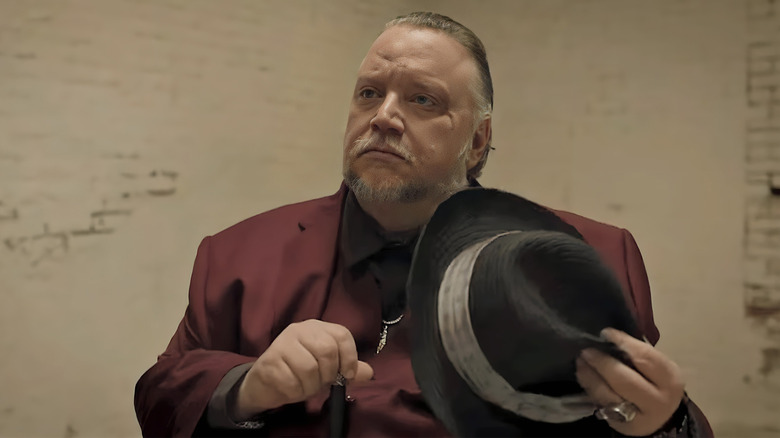
In the world of "Barry," the titular assassin-turned-actor has made quite the laundry list of on-again, off-again enemies. From his longtime handler Monroe Fuches to the lovable Chechen mobster NoHo Hank, many have turned from being Barry's friend to wanting Barry dead. In Season 4's third episode, "you're charming," NoHo Hank and Cristobal react to Barry's cooperation with the authorities regarding the pair's growing "crime utopia" exactly as expected: they look to see him assassinated.
Assassinating someone in federal custody is no mean feat, however, so the pair consult with an absolute monster, a man called Toro, who arranges the hit with a pair of assassins who also happen to be podcasting gearheads (it's Los Angeles, everyone has a podcast).
If Toro looks surprisingly familiar to you, it's obviously because he's played by none other than Guillermo del Toro of Pappy McPoyle fame on "It's Always Sunny In Philadelphia" (in addition to being one of our era's greatest living filmmakers). The surprising and excellent cameo cements del Toro, a longtime "Barry" fan, forever into the series' history. In an interview with IndieWire, series creator Bill Hader reveals that the cameo began as all great collaborations do, via a random text message.
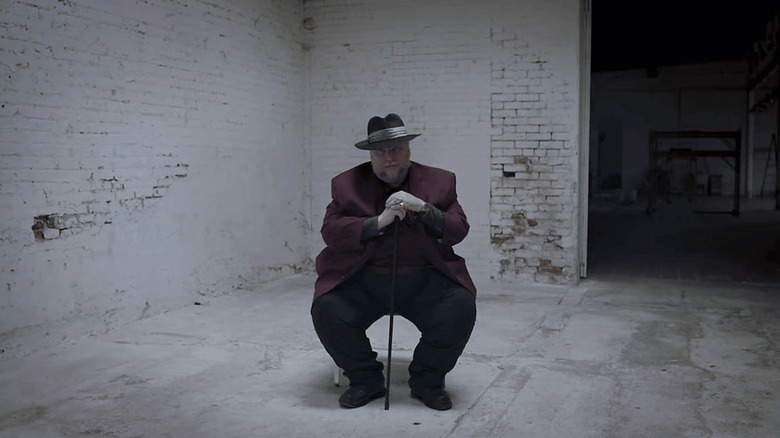
In the interview, Hader recounts that, out of the blue, "Guillermo sent me a funny text [asking], 'Could I be in 'Barry'?" Hader continues to reveal that del Toro may not have fully expected the cameo to happen. "I think he didn't think I would [ask him]," the "Barry" co-creator explains, "People say [they want to be in the show] sometimes, and it never happens."
Hader had an idea. "But then I thought, 'Actually, there's a part that he'd be really good in,'" Hader says, "I called him and said, 'Yeah, I have a character for you. His name's Toro.' And he went, 'Oh, man. Really?'"
Hader leveraged the character's name to further entice the creature feature king to commit. "I said, 'Well, the character's called Toro, kind of saying, 'Well, now you've got to do it.'," Hader explains. The pair found a date that worked with del Toro's schedule.
It all was a bit of a gamble. "I didn't know if he could act or not," Hader details. Moreover, it was hard for the auteur to leave the directorial instincts at home. As Hader explains, "He would give me s**t about how I was blocking [ ... ] he said, 'The eye-lines won't match because you're on too wide of a lens.'"
Hader took it in stride. "I was like, 'Guillermo, it's not really your call, man.' [...] 'Cate Blanchett didn't say this s**t to you on your last movie,'" he humorously recounts, reiterating, "But no, he was very sweet." The scene is as short as it is excellent, but the surprisingly impactful scene sets in motion the rest of season 4.
Read this next: The Best TV Shows Of 2022, Ranked
The post How Guillermo del Toro Wound Up With A Role In Barry Season 4 appeared first on /Film.
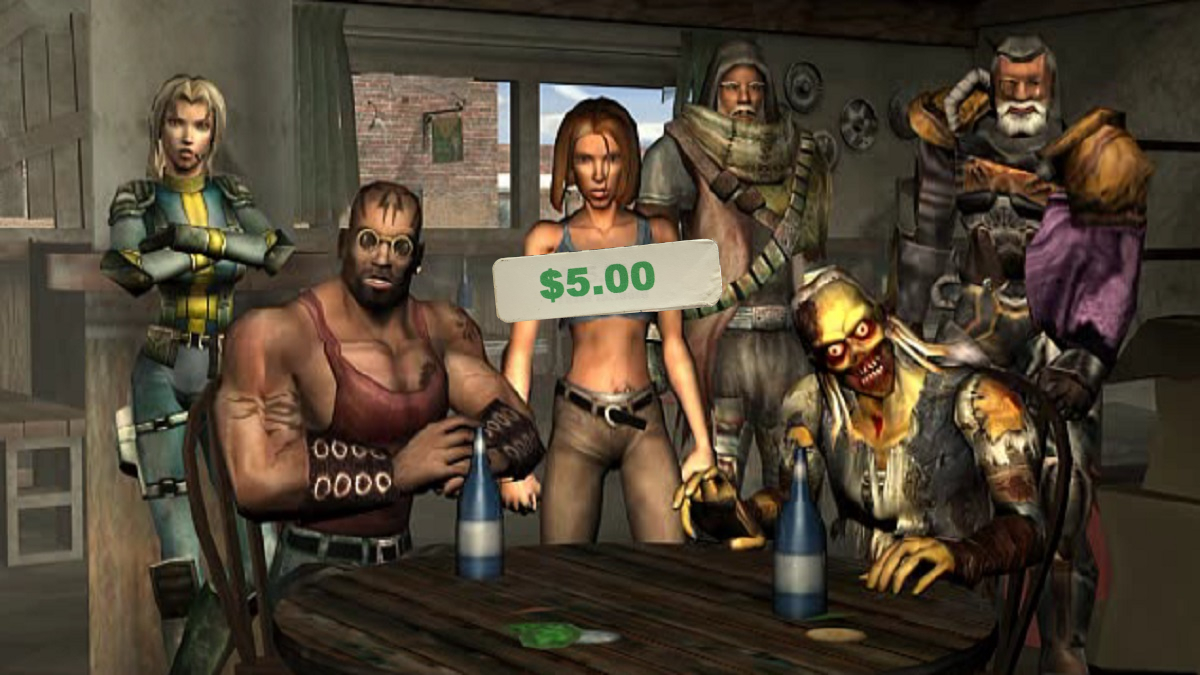
I really thought this was going to be worse. Hearing about 2004's Fallout: Brotherhood of Steel in the years since Fallout 3 introduced console players to the franchise, I thought it was going to be an abomination. If Fallout Tactics: Brotherhood of Steel (don’t get them confused) is the series’ black sheep, then surely Fallout: Brotherhood of Steel was the sibling that died early because it was born without a butthole.
I was led to believe it was a barely related cash-in made by people who paid no care to the license it was based on. It has advertising for Bawls in it; that caffeinated energy drink with the cheeky name. Bawls. There was no way it could possibly be good.
It’s not, but it definitely has a butthole.
[caption id="attachment_376588" align="alignnone" width="640"] Image via Fallout.wiki[/caption]
Image via Fallout.wiki[/caption]
I guess there’s a lot to be said about lowered expectations.
To be fair, Fallout: Brotherhood of Steel was being developed around the same time as the planned Fallout 3 was at Black Isle Studio. Black Isle was having its own issues. A lot of the team responsible for the original Fallout left because of a disagreement with Interplay. In 2001, Interplay was bought up by Titus, which is a name I can’t say without my body trying to reject my vocal cords. The remaining team at Black Isle continued working on Fallout 3, only to have it cancelled and the studio shuttered in 2003.
Fallout: Brotherhood of Steel continued development in-house at Interplay. It’s not the development team’s fault that Black Isle got the shaft, as they so often did, but you can see why fans weren’t exactly receptive to its existence. It probably would have been more welcomed if it was a console title that was arriving alongside another whole-fat title in the series, but that wasn’t the case anymore.
Conceived as a console-focused spin-off of Fallout, Fallout: Brotherhood of Steel builds on the same engine as Balder’s Gate: Dark Alliance. Rather than a full RPG like the main series, it’s more of a dungeon crawler not too far removed from Diablo. There are still a number of RPG systems running beneath the action, but it’s a much more linear experience. You won’t be getting a car, driving out to Reno, and becoming a porn star.
And that’s a bit of a shame.
[caption id="attachment_376589" align="alignnone" width="640"] Image via Fallout.wiki[/caption]
Image via Fallout.wiki[/caption]
That said, when taken as a spin-off, Fallout: Brotherhood of Steel is… fine. It’s amusing to look back at the reviews that came out about it at the time, since they’re very quaint by today’s standards. The complaint I saw repeated frequently was the game’s use of “four-letter words,” and crude humor. Fuck, I’m glad we’re past the days when dropping an f-bomb was considered shocking and obnoxious. This was 2004, just shy of the 2006 release of Scarface: The World is Yours, which set a new standard for fuck’s sake.
It’s honestly not that bad. It wasn’t so intrusive that I even really noticed that Fallout: Brotherhood of Steel had an affection for the word until I checked the opinions of others. The humor is a little, er, ‘aughties. I don’t personally see how it’s so intrusive, but it has aged poorly. But, I mean, in Fallout 2, you could lose an arm wrestle with a super mutant, then wake up with a ball gag in your inventory. The implications aren’t so subtle. I’m just saying, the bar wasn’t set particularly high when it comes to the sophistication of the humor.
A lot of other complaints were more on the mark. The combat, for example, is boring. This isn’t really too out of the ordinary for dungeon crawlers, I just don’t particularly dig it. You have a lock-on system, but you can only move while firing if you’re playing as one of the female characters. There's a dodge button, but since this isn’t Dark Alliance and enemies are using firearms, it’s not all that useful. You can really just turn your brain off for much of the fighting, which will probably be a positive from some perspectives, but I don’t love it.
[caption id="attachment_376591" align="alignnone" width="640"] Image via Fallout.wiki[/caption]
Image via Fallout.wiki[/caption]
The level design holds up a bit better. I generally have a distaste for dungeon design, regardless of whether it’s Zelda or Fallout. However, through the game’s three chapters, there’s a lot of variation in location. Even when you get to areas where you’d expect things to become samey, there manages to be distinct visual differences.
There’s maybe a bit too much love for instant death here. Fortunately. save points are extremely frequent, and you can always find one at the beginning of each section.
But while there’s a lot of variety in the locations of Fallout: Brotherhood of Steel, there isn’t so much when it comes to equipment. New weapons and armor are very gradually drip-fed, and a lot of them are largely interchangeable. Ammunition is really the bigger concern, as firearms tend to eat up a lot of it in an effort to deal damage. For much of the game, I simply went with melee weapons, which themselves are very interchangeable. It just meant that I didn’t have to deal with ammunition, and it made the combat feel slightly less mindless.
[caption id="attachment_376592" align="alignnone" width="640"] Image via Fallout.wiki[/caption]
Image via Fallout.wiki[/caption]
Altogether, you’re looking at 10-12 hours to get through Fallout: Brotherhood of Steel. There is some replay value, as playing through it will unlock additional characters. Still, it feels like too much game for what it is. While the levels get more interesting as you progress, the gameplay feels too monotonous and worn thin by that point.
I’m sure this isn’t going to surprise you, but it also doesn’t adhere very strictly to continuity. The developers were obviously familiar with the world of Fallout, so it’s not as though this spin-off is completely unrelated, but they seem to have been more focused on making a title for console gamers rather than make their mark on the series. Considering Fallout 3 didn’t do the best job of sticking to the established narrative, it’s maybe more forgivable today.
I’m mostly bringing this up as a warning. I don’t have much reverence for the continuity of the series, but some people do, so there it is.
[caption id="attachment_376595" align="alignnone" width="640"] Image via Mobygames[/caption]
Image via Mobygames[/caption]
I’m going to be honest; I kind of enjoyed the experience. This may be to do with the fact that my expectations were dredging the ocean floor. I was kind of expecting Fallout: Brotherhood of Steel to be painful to play, and it’s definitely not that bad.
However, it’s easy to see where the rather loud complaints came from. Interplay was a pretty horrible parent to the Fallout series to begin with, and that only seemed to get worse when Titus took over. Maybe the game itself isn’t that bad, but the company politics going on around that time certainly were.
The developers definitely didn’t just phone it in. While Fallout: Brotherhood of Steel isn’t a great game, it’s not just a quick write-off. You can tell the team behind it at least cared to some extent about the quality of the final product. I guess what I’m saying is; we can all blame Interplay and, by extension, Titus for why Fallout: Brotherhood of Steel receives so little love. We all rely on reputation, to some extent, to decide on what games we play, so it’s a bit of a bummer when the real reason for a game's derision has to do with the company behind it and not the game itself.
On the other hand, I now want to try the Baldur’s Gate: Dark Alliance games. The older ones, I mean. If Fallout: Brotherhood of Steel was Dark Alliance, but not very good, then Dark Alliance must at least be better than not very good.
For previous Weekly Kusoge, check this link!
The post Fallout: Brotherhood of Steel doesn’t glow, but it isn’t radioactive appeared first on Destructoid.
Read more of this story at Slashdot.

There’s a lot of magical thinking surrounding retirement. The rule of thumb is to target about 80% of your current income for your retirement, and while that number is a little sketchy, it’s useful in that it highlights just how expensive retirement can be. When you’re young, you think retirement is so far away …

At this point in history, one would assume we have already explored the map of the world of pizza to its edges (which are probably stuffed with cheese). You can grill it, shave truffles on it, use cauliflower instead of dough, and jam the crust full of all kinds of weird crap. But a recent discovery revealed to me…
The modding team behind RBDOOM-3-BFG has released a new version of it that replaces OpenGL with DirectX 12 and Vulkan. According to the team, and in some really demanding scenes, DX12 can almost double the game’s performance. As the team stated: “This is actually one of the most demananding scenes in Doom 3 with many … Continue reading RBDOOM-3-BFG 1.5.0 replaces OpenGL with DX12, almost doubling performance →
The post RBDOOM-3-BFG 1.5.0 replaces OpenGL with DX12, almost doubling performance appeared first on DSOGaming.
CISA has opened proposed guidance for secure software development to public review and comment.
The post CISA Asks for Public Opinion on Secure Software Attestation appeared first on SecurityWeek.
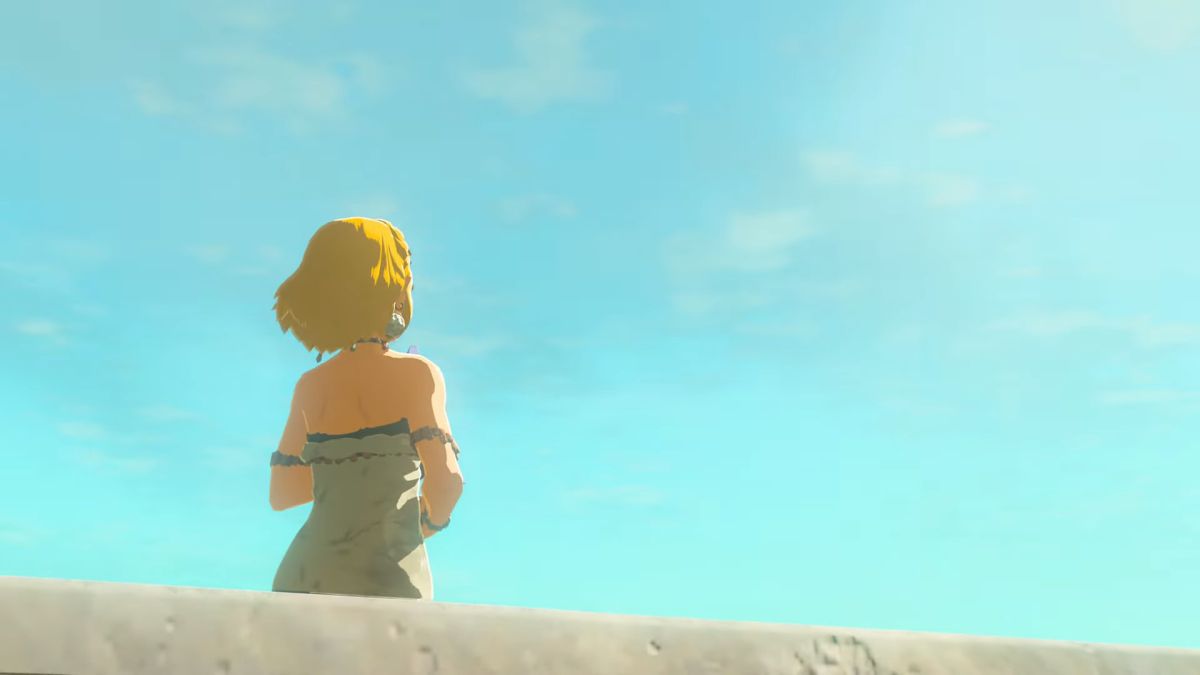
We're under two weeks out from the release date of The Legend of Zelda: Tears of the Kingdom. But it seems like you'll already want to start locking in those muted words and phrases. It looks like Zelda: Tears of the Kingdom has leaked.
Images and clips of the upcoming Switch game began to circulate at some point over the last 24 hours, on various gaming forums. This includes footage of areas both seen and unseen in prior footage.
We won't be sharing any of the information here, either on what or where it is. Suffice it to say, I've looked, and can at least verify that it looks quite real.
https://www.youtube.com/watch?v=uHGShqcAHlQ
While we won't share spoilers here, it's still a good idea to start keeping an eye out on various forums if you want to stay completely unspoiled. My personal recommendation is to make use of any keyword-blocking features on social media, if available, and also be wary of browsing any "new" or "recently updated" tabs. And also, be nice to your local forum moderator, as they're about to have a very long 11 days between now and the release date.
It is, again, wild to think that we're just about 11 days out from the release of the sequel to Breath of the Wild. First announced back at E3 2019, and later officially named, The Legend of Zelda: Tears of the Kingdom is a direct sequel to 2017's Breath of the Wild. We've seen teasers and learned about Link's inventive new hand powers, and seen plenty of teasers for what's in store for Hyrule.
Now, we're just a little over a week out from the full launch of Tears of the Kingdom. May your feeds be spoiler-free as we rocket toward May 12.
The post PSA: Looks like Zelda: Tears of the Kingdom has leaked online appeared first on Destructoid.
Read more of this story at Slashdot.
Read more of this story at Slashdot.
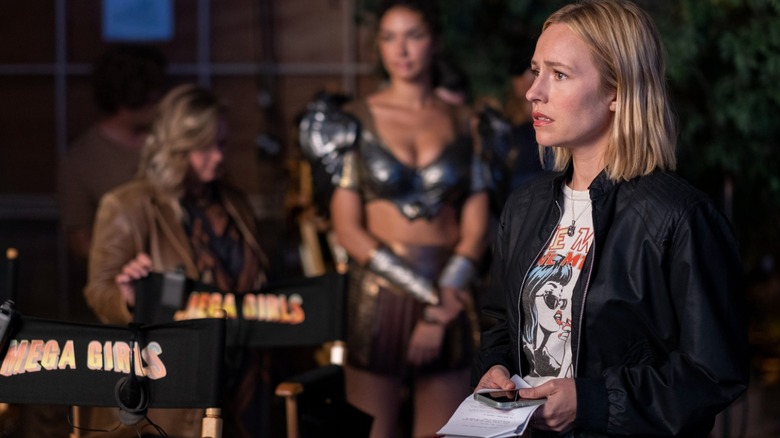
This post contains spoilers for the latest episode of "Barry," as well as sensitive, possibly triggering content.
The latest episode of the final season of "Barry" might be the show's darkest chapter yet. It's certainly among its most heartbreaking; there's the death of Cristobal (Michael Irby), and of Hank's (Anthony Carrigan) heart with him, a scene that unfolds with excruciating slowness and then, suddenly, all at once. There's the shooting of Gene's (Henry Winkler) son, a senseless, awful tragedy that happens to a character whose arc has always been defined by a tidy sense of dramatic irony. And there's Barry (Bill Hader), the black hole around which so many characters still orbit despite themselves.
None of these plots, however, hurt quite like Sally's (Sarah Goldberg). At first glance, Sally's storyline in the latest episode of "Barry" is nowhere near as gutting as the bleak twists of fate mentioned above. She visits the set of a Marvel-esque movie where she has what could be described as a "big break." When Kristen (Ellyn Jameson), the woman she's ostensibly coaching, chokes, Sally steps in and demonstrates her lines perfectly. It's an obvious gambit, but a successful one. As she heads back to her trailer, a male crew member assures her that he can get her great roles if she sticks with him. You can see Sally begin to shut down during this conversation; she's been chewed up and spit out by Hollywood before, and perhaps knows better than to get on the ride again.
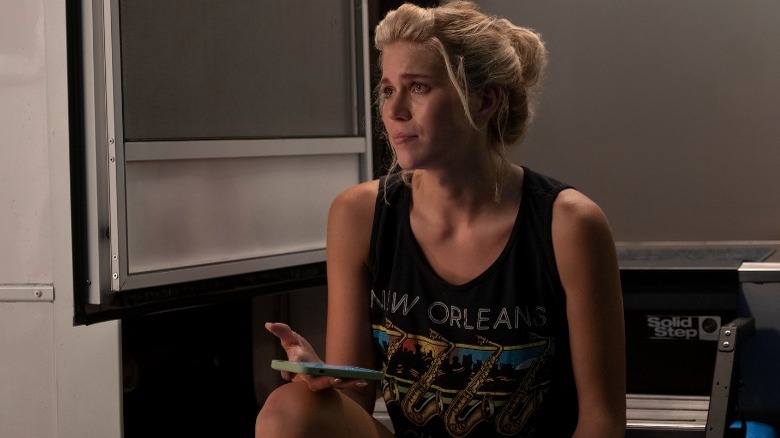
That's not the sad part, though. Sally's arc is quietly heartbreaking because although she seems ready to call off her abusive relationship with Hollywood, she's eager to get back to an even more dangerous relationship -- with Barry. When Kristen tells Sally her ex broke out of prison, a helicopter whir drowns out whatever other words of support she might be offering. Sally doesn't look scared but rather stunned, then contemplative. She tilts a little as she stands, as if she might fall over, but then she says, "Uh, I'll be okay!" We don't see Sally for roughly the next ten minutes of the episode, but when we do, she's rushing into her apartment, eager to discover that Barry has broken in.
Sally's decision here is made silently and swiftly. There's no begging as in Hank and Cristobal's goodbye. There's no beautifully choreographed action scene or sudden violence to signal to viewers that s**t has just gotten real. We're given just a few seconds of Goldberg's face to show that, even as she reels from the news of Barry's prison escape, she welcomes it. She wasn't lying when she said she felt safe with him, or if she was, she still at the very least feels better with him than she does on set or with the suffocating judgment of her parents. "Barry" has spent four seasons crafting a story about Sally's status as an abuse survivor, and in a matter of minutes, the show sees Sally blow up her life to be with a dangerous, angry man. In any other series, we would be cheering for the long-time love interest to choose the protagonist; this time, we'd be forgiven for crying.
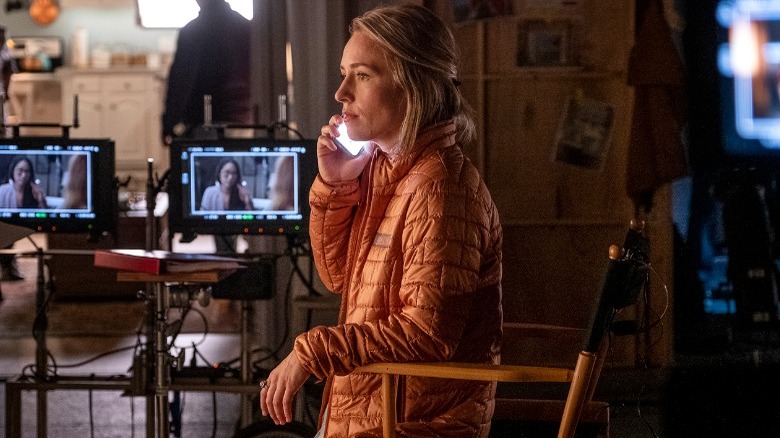
"Barry" didn't always look like a story about abuse, but Hader and co-creator Alec Berg have been fueled throughout its run by a clear need for perpetual motion -- a constant, ambitious evolution of Barry as a character and the series as a whole. Viewers have known about Sally's history as an abuse survivor from early on, back when Barry still maintained a somewhat likable persona when he wasn't killing people. By season three, though, the cracks were starting to show.
One of my favorite shots in that season is the one in which Sally makes a plate of food for Barry, cracks open a beer, and anxiously gets a video game console situated for her boyfriend. It's a response that comes over Sally like muscle memory in action, but it's also clearly a holdover from a past relationship; a few scenes before, Barry screamed in Sally's face at work, and his verbal and emotional abuse triggered her into a return to the peacekeeping behavior that kept her safe in the past. There are no lines in the script to explain all this then, either. "Barry" tells us about the sorry state of the pair's relationship entirely through its visuals and Goldberg's performance.
There's a term used in trauma therapy and psychology called "revictimization." It refers to the tendency for people who have experienced abuse once to be exposed to it again, at the hands of someone else. There are complex factors that can contribute to survivors' likelihood of experiencing revictimization, but none of them are the fault of the abused party. Regardless of the reasoning, research shows that people who assault or abuse are at a higher risk of experiencing it again later in life.
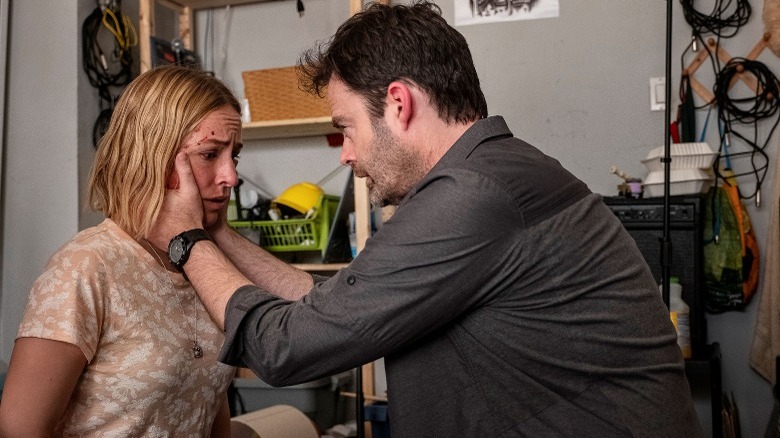
Abuse survivors are also likely to return to their abusers after leaving, in large part because the cycle of abuse makes them feel isolated and dependent on their abuser, or confident that the abuser is actually a safe or "good" person. While Barry perhaps isn't shown as a typical abuser -- we only saw how erratic and threatening he could act in the midst of a breakdown beginning in season 3 -- we did actually see Sally attempt to leave him before. In last season's finale, after he proposes a horrifying plan to terrorize her former colleague, she tells him to get out of her house. Only, Sally is attacked right after that, and the fact that Barry helps "save" her from her attacker (by covering up his death) likely makes her feel bonded to him once more.
The tendency for victim-blaming in these situations is high, and in the case of "Barry," a show that bucks our expectations at every turn by making its protagonist its villain, fans have actually blamed Sally for dumping Barry. "Yeah, she's a little narcissistic and she can be selfish," Berg said in an interview with IndieWire after the season 3 finale, "[But] he's a murderer — why are you worried about Barry in this relationship?" It's not just Sally who's been swayed by the illusion that Barry's a good guy; audiences have fallen for it, too, looking past the biggest red flags imaginable or justifying the character's actions long after they became unforgivable.
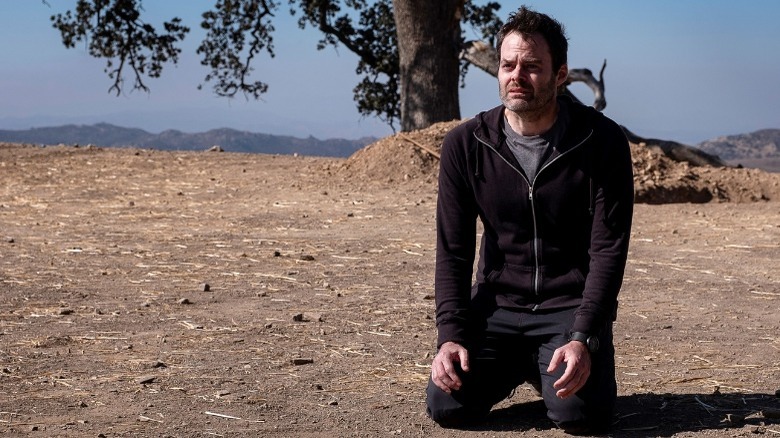
We can't know exactly what Sally was thinking when she returned to Barry this episode, proposing the pair leave town together. We can't know if she felt like she was out of other options, or if she truly saw him as a safe bet, although Goldberg says she thinks Sally felt some safety in being witnessed at her worst and not judged by Barry. We can't know whether Sally feels upset about being drawn to another angry man, or whether she's well aware of the complexities of revictimization. We can't even know if her moment of resolve on set may have been an acceptance of danger -- an evaluation of every possible bad outcome, including her own possible death, that still inexplicably led her back to Barry.
So what do we know? We know that Barry is far from safe, and that Sally quietly makes a choice here that's both extremely upsetting and extremely common among abuse survivors. In nearly any other series, this type of reunion would feel like the start of a beacon of hope, and the start of a happy ending. In "Barry," it feels like heartbreak.
"Barry" airs on HBO and HBO Max on Sundays at 10pm ET.
If you or someone you know is dealing with domestic abuse, you can call the National Domestic Violence Hotline at 1−800−799−7233. You can also find more information, resources, and support at their website.
Read this next: The Moments That Defined TV In 2022
The post Sally's Choice Is The Most Quietly Tragic Part of An Extra-Dark Episode of Barry appeared first on /Film.
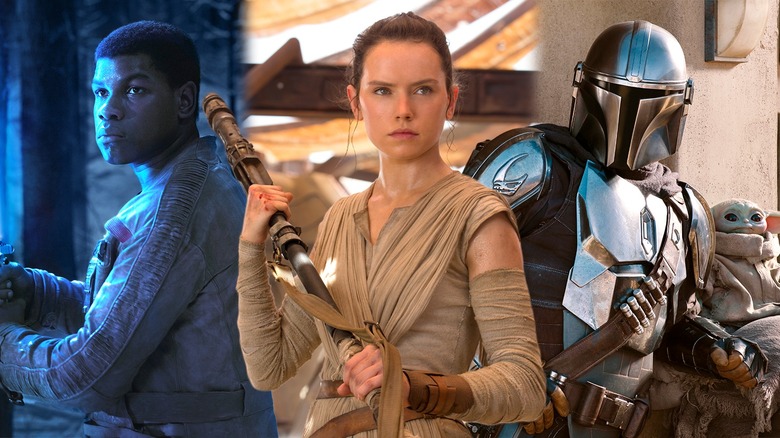
As announced at Star Wars Celebration, Lucasfilm is not yet done with characters from the Skywalker saga. A new feature, set 15 years after "The Rise of Skywalker," will see Daisy Ridley return as Rey Skywalker, now a Jedi Master. Other Jedi, whose identities remain as yet unknown, will be in disarray. Chances are, they won't call it "Episode X," just to keep the sanctity of the Skywalker saga at George Lucas' planned nine episodes, yet it's definitely a continuation of the universe we know and (mostly) love.
Here's where we all hope they learn from the sequel trilogy's mistakes. Love or hate any of those films individually, most agree that any problems they have arose from Lucasfilm not developing a coherent plan, thereby allowing directors J.J. Abrams and Rian Johnson to seemingly contradict each other, with some awkward reconciliation at the end. "The Rise of Skywalker" couldn't possibly fill all the plot holes that ensued, but the Rey movie might need to take over on that score.
Here's a look at what the movie at least needs to address before blazing a brand-new trail. Some of these items have been touched on in expanded media, but deserve a fuller fleshing out for all fans.
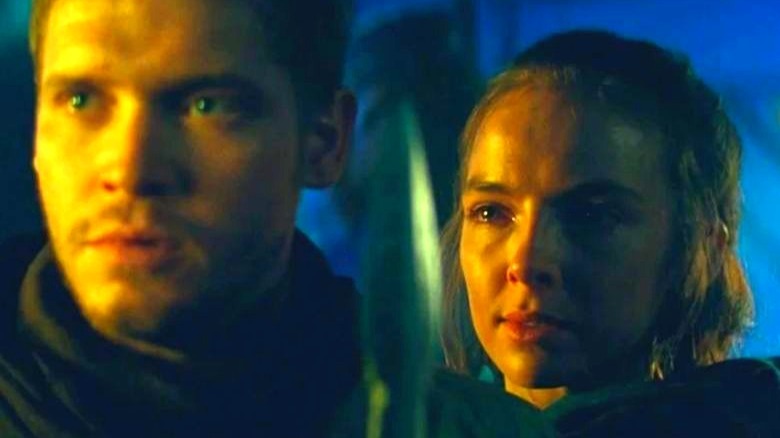
Rey's parents, whom she barely remembers, played a key role in the sequel trilogy by being a mystery that nobody, not even the directors, knew the real answer to. "The Force Awakens" implied she had a significant heritage. "The Last Jedi" proclaimed her parents were absolute nobodies with drinking and gambling issues. Then "The Rise of Skywalker" revealed she's Emperor Palpatine's granddaughter, which made fans do a double take, as they did not want to envision Palpatine ever having sex.
Of course, he probably would have. Rich, wrinkly old men frequently use their money and power to get some action on the side. Still, nobody wants to think about it, which is probably why Disney, via the "Shadow of the Sith" novel, revealed Rey's father to be an inferior clone attempt, or strandcast, without a strong Force connection. Though officially canon (in the same way all the tie-in novels are supposed to be now), that story, heavy with Sith mysticism, is entirely subject to revision by subsequent filmmakers. It also depicts events that, seemingly, the adult Rey does not know or remember yet.
Rey would surely want to know more about her parents than merely that one of them was Palpatine's "son," if we can really call a strandcast that. How much will she learn? How can she let it all go? How did the midichlorians apparently skip a generation almost completely? She needs to know, as do we.
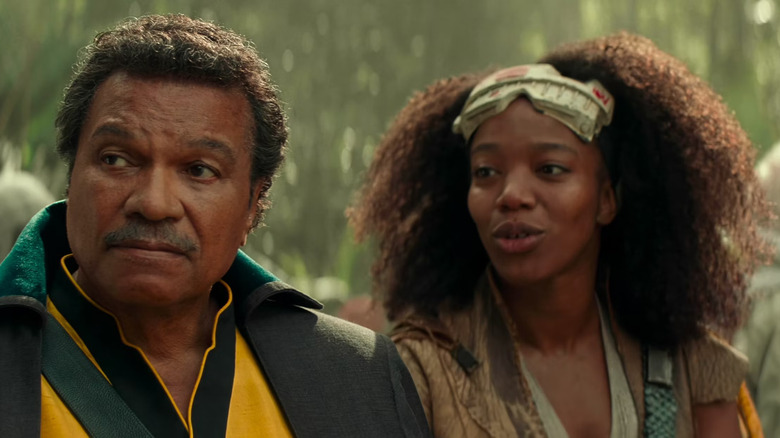
Despite strong hints at the end of "The Rise of Skywalker" that Jannah (Naomie Ackie) was Lando Calrissian's daughter, Lucasfilm has yet to fully confirm it. What we do know, according to the novels, is that Lando had a daughter named Kadara, who was kidnapped by the First Order at the age of 2. Jannah, conveniently, was also kidnapped by the First Order as a child and raised to be a stormtrooper. Is it just an incredible coincidence? Fifteen years along in the timeline, somebody has to know for sure. The movie novelization arguably implies Jannah is not Lando's daughter, as it doesn't play up a familial connection between the two. It suggests Jannah merely reminded Lando of his daughter, but it's ambiguous enough that Lucasfilm could decide to retcon it if they wanted.
A lot presumably depends on what the filmmakers have in mind, and whether Naomie Ackie returns. If she doesn't, Kadara can turn out to be someone different. One way or another, though, the only surviving child of the original trilogy heroes -- Wicket's junior Ewok aside -- needs to factor in. Lando basically got screwed by the sequel trilogy, almost as badly as he screwed Han over back in the day. Don't let his legacy go to waste.
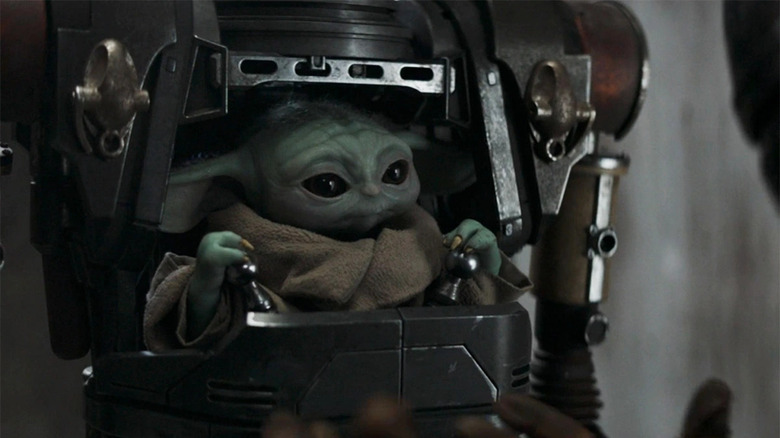
Two things about everyone's favorite baby Yoda-ish hero are true. One: his species lives up to 900 years. Two: there's no way Disney is insane enough to kill off such a merchandising cash cow. That being said, he'll probably still be around in the timeline, but what will he be doing? And more importantly, where was he when the First Order rose? The real answer, obviously, is that he hadn't been invented yet. Now that he has, and his story has intersected with major players, it seems kind of important that an apprentice of Luke Skywalker (however briefly), who was also pals with Boba Fett for one hot minute, didn't make any kind of appearance when the entire galaxy was freaking out about Luke's disappearance.
Now that Luke's Force ghost has his head back in the game, it makes sense that he and Din Grogu might talk. Given the latter's lifespan, he could easily be in his surly adolescent phase by then, though he'd also have taken the creed of the Watch. (Since he's beginning to almost talk on "The Mandalorian" now, it makes sense he'd be fully able 15 years post-First Order). How might he react to a bunch of new Jedi running around? With space dad Din Djarin likely quite old or deceased, would the youngster decide to re-up his Force training?
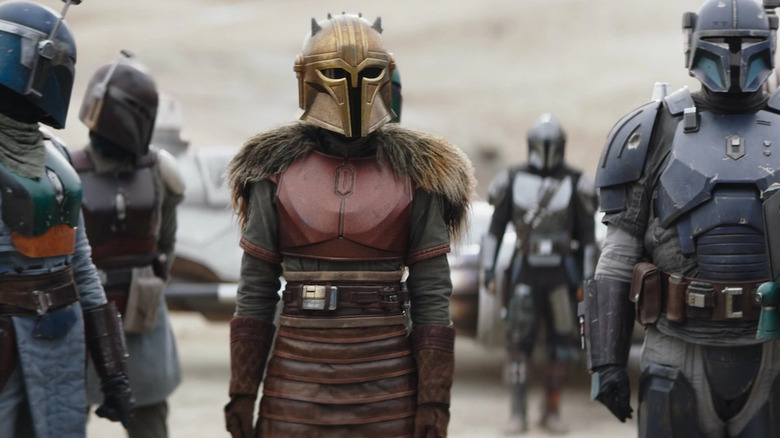
Assuming "The Mandalorian" doesn't end with Mandalore getting the Death Star treatment, there's a whole population of Mandalorians out there who also sat out the First Order-Resistance conflict. Granted, it didn't last remotely as long as the Empire's reign, but we're still talking about an entire race with a grudge against the dominant evil power. It's not impossible that Mandalore could elect a villainous leader, as they've done before, but even the biggest jerk with a jetpack might balk at allying with the forces of Palpatine, which previously bombed their homeworld to (perceived) death.
So what have they been doing? We know they're very good at hiding, so they might have all gone underground. If Din Grogu emerges (and he probably will because Disney likes money), he'll be the key, as he's more Mandalorian than Jedi at this point. As the first Mandalorian that we know of to not be a standard-sized humanoid species, maybe he can even open the Creed up to more aliens. How about we have a Mandalorian academy this time, rather than a Jedi one?
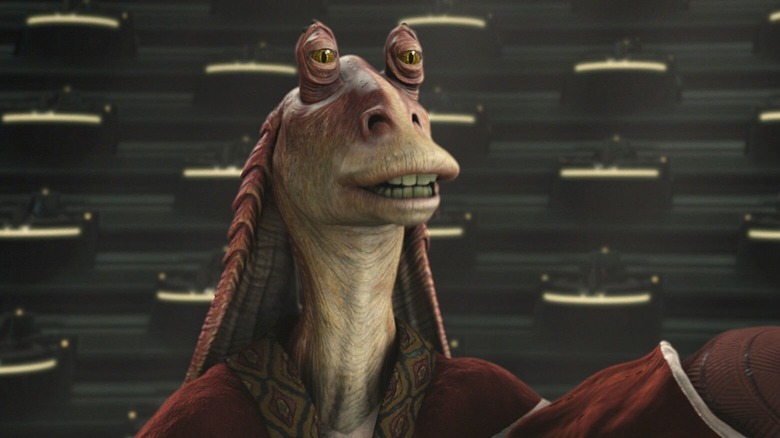
Many fans hate Jar Jar. A significant portion these days do not. Regardless of one's individual feelings, however, there's no dispute that he's a significant character in the history of the galaxy far, far away. Through sheer Buster Keaton levels of convenient clumsiness, he helped defeat the Trade Federation in battle; then, through misguided Senate voting, basically gave Palpatine martial law without considering the downside. He's also not confirmed dead. J.J. Abrams made a joke about putting a familiar Gungan skull on Jakku but never went through with it. Jar Jar's final fate was revealed as an interlude in the novel "Empire's End: Aftermath," in which he's living as a street performer on Naboo and offers to teach a child how to be a professional clown. It's a tragic turn of events for Jar Jar, who is ostracized from society after being blamed for helping create the Empire. It's unknown if the Gungan lived through the First Order-Resistance conflict depicted in the sequel trilogy, but if he did, the new movie could be a place to give the character a more proper sendoff. While there's nobody left in the Resistance that he'd be particularly attached to, Jar Jar's role as a historical figure could surely prove useful to new students. Actor Ahmed Best, however, would probably much rather play Kelleran Beq.
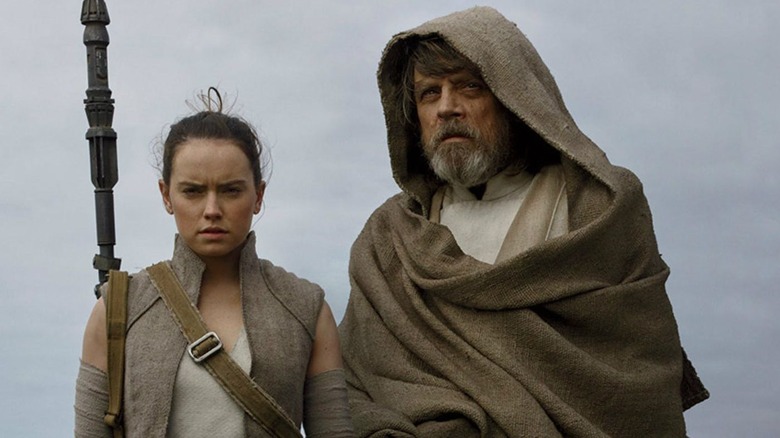
Luke Skywalker was pretty adamant that the Jedi needed to end. Even when he sort of backtracked, it was to tell Rey to finish her fight, not start a new one. So why would she have started the Jedi Order again?
Kathleen Kennedy has indicated we probably shouldn't expect a lot of Force ghosts hanging around, so we don't (and shouldn't) need ghost Luke to pop up and say, "Hey, I've changed my mind again!" However Rey leads the Jedi moving forward, what we do need is a new coherent philosophy; one that addresses their institutional flaws in the prequel era, the ease with which they were duped in the Clone Wars, and the way Jedi Masters deal with students who are in the process of being seduced by dark side wielders. "Not trying to kill them in their sleep" should be Jedi 101 -- it's dishonorable, even if your foe is someone as obviously evil-looking as a Darth Maul type.
Could we see the long-rumored "Grey Jedi," offering a balanced approach? Or, perhaps, a more nuanced understanding and distribution of the Force.
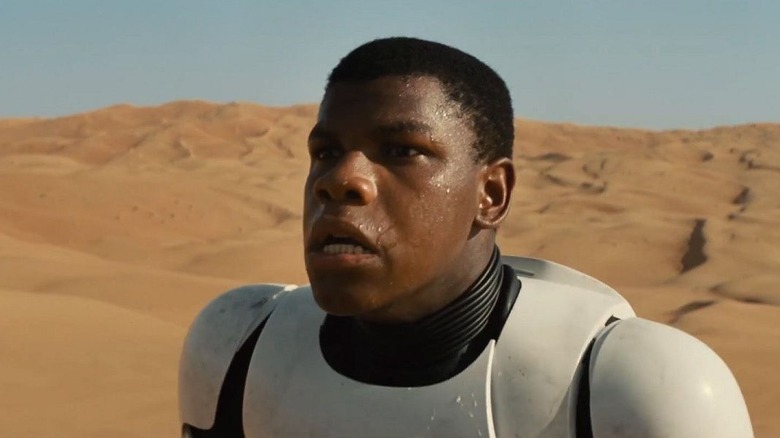
As of this writing, the odds of John Boyega returning seem about 50-50. After "The Force Awakens" established a potential romantic chemistry between Finn and Rey, subsequent installments dropped the ball tremendously, pairing Finn with different female partners in each subsequent installment. Author Alan Dean Foster, who wrote the official "Force Awakens" novelization, saw the Finn-Rey pairing as romantic but was asked to remove any hints regarding a potential relationship from the book. As the sequel trilogy went along, the filmmakers gave us the vaguest hint of a Finn-Rose romance before swerving again and teaming him with Jannah.It was in that last pairing that J.J. Abrams finally got around to explaining the title of "The Force Awakens" -- it involved Finn and similar stormtroopers in other locations suddenly sensing they were on the wrong side. Even though he and Jannah aren't Jedi in the making, at least so far, they felt the Force telling them to leave the First Order. That set many of the events of the sequel trilogy into motion. What, though, does it signify for the Force's future? If it can be felt and put to use by not just Jedi and Sith, it's going to shake things up. There is always a balance, and if the light side can awaken the good in normies, surely the dark side has a similar trick.
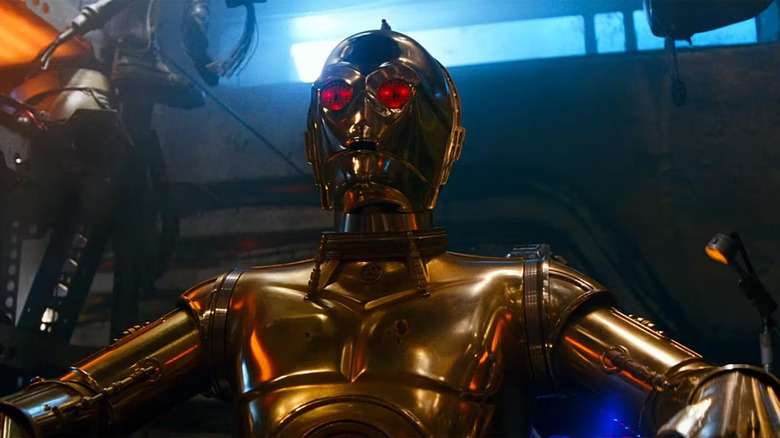
If "The Rise of Skywalker" clarified anything, it's that Lucasfilm will not kill off any popular supporting legacy characters it doesn't have to, which is to say aliens and droids that don't age. The movie tried to shock us with Chewbacca's death and C-3PO's memory wipe, only to backtrack on both almost before they'd even sunk in. So what to do with them? Likewise, there are human supporting characters who've been spotlighted but sidelined, like Rose Tico and Beaumont Kin. They don't need to be brought front and center, but they all deserve better than Cara Dune's Poochie-style offscreen sendoff. Indeed, it's clear that for the most part, neither Abrams nor Johnson really knew what to do with Chewie and Threepio, save knowing they had to do something. Threepio somehow getting his red arm replaced off-camera during a major battle was a bizarre choice indeed.
Rose and Beaumont might be better served by a TV series on the side, although Rose might work in a Mon Mothma-esque leadership role. Chewbacca and Threepio deserve a happy ending. The neurotic protocol droid should go back to protocol, possibly on Jack Black and Lizzo's planet. As for our favorite Wookiee, he should have a real family in canon at last, so we can finally replace the images in our brains from the Holiday Special that have been unpleasantly seared.
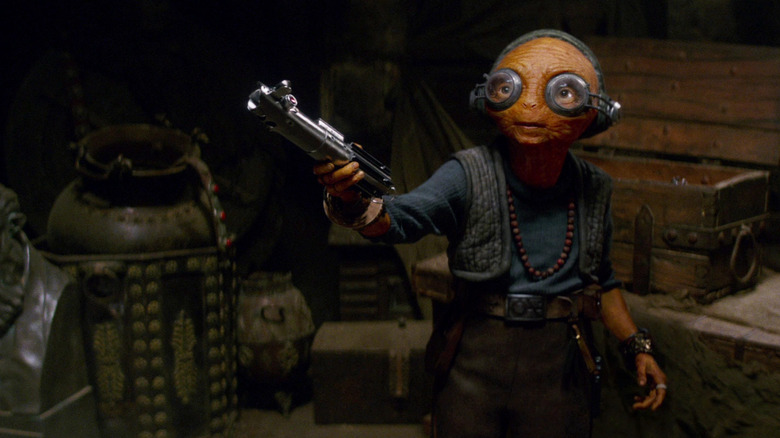
In "The Force Awakens," Maz Kanata promised that the story of how she got Luke Skywalker's lightsaber was for "another time." That time was nowhere in the course of the sequel trilogy, as it turned out. The comics have fleshed some of this development out, but it's not the only secret she's keeping. Why does she manage labor disputes at gunpoint, for example? What's the story with the real master hacker that Finn and Rose never got to actually meet? Maz's motives seem pure, as she's with the Resistance at their base in "The Rise of Skywalker" and she's with Leia when she dies. Could she have planned the Canto Bight trip as a set-up, though? And if not, couldn't she at least have told them where to park?
Maz was initially described as a pirate and seems much more morally ambiguous on paper than in Lupita Nyong'o's affable performance. Considering her establishment catered to both heroes and villains, she has to have a darker side than we've seen. Even if the character's too old to live much longer, some of her mysteries need to be revealed.
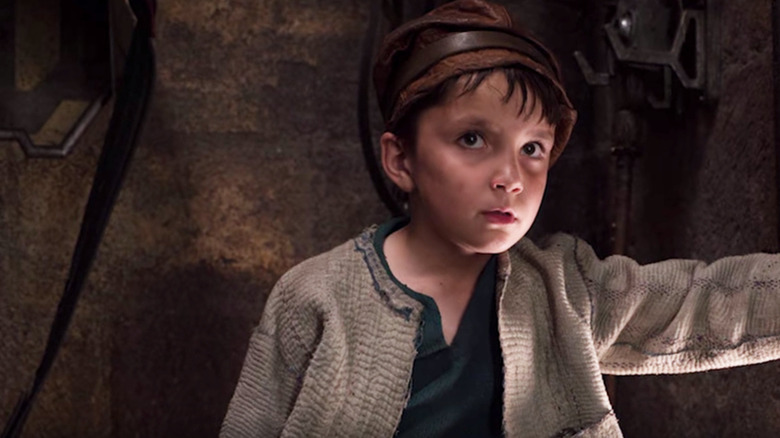
"The Last Jedi" established that within the "Star Wars" universe, there's a planet catering to high rollers who bankroll both sides in major conflicts, and, oh yeah, their casino is built on child slavery. Surely the prequels can be our guide to the fact that leaving intact criminal systems built on slavery isn't a good idea. Not just because slavery is bad in general, and child slavery worse, but because if even one kid gets free and becomes a Jedi, he might come back and commit genocide. Do you want Broom Boy to become the next Darth Vader?
A whole lot of fans hate Canto Bight, with its arbitrary parking rules and insufferably Disney Channel-ready enslaved moppets. Regardless of that, it needs to be dealt with. Rehabilitation, as seen in "The Mandalorian," can be iffy, but killing them all is not the Jedi way, except when the enemies are sentient battle droids who say "Roger" a lot.
Look, with all the political differences and bigotry in the world today, even most Earth-based humans agree that slavery is bad and ought to be illegal everywhere. The "Star Wars" universe, which frequently presents as more enlightened, should take a stand that's at least as good as ours, if not more so. They've already had a couple of civil wars, so now's the perfect time for a galactic Emancipation Proclamation.
Read this next: Every Star Wars Project Currently In Development
The post 10 plot threads the new Star Wars Rey movie needs to resolve appeared first on /Film.
Read more of this story at Slashdot.
Read more of this story at Slashdot.
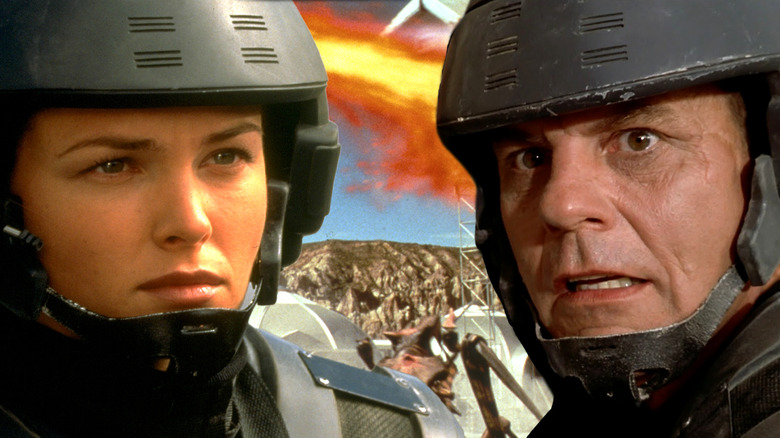
"Starship Troopers" failed to land when it opened in November 1997. Casper Van Dien and Denise Richards were not bankable leads, and audiences expecting a conventional sci-fi epic were thrown off by the film's curious style, which is a mix of televisual soap operas and satirical militarism. Consequently, "Troopers" received a mediocre "C+" from CinemaScore and grossed just $121 million against a $100 million budget (via The Numbers).
Critics were not best pleased, either, especially Stephen Hunter, who attacked "Troopers" as a film that "presupposes" Nazism. Such literal-mindedness misses that Paul Verhoven's film is satirical meta-propaganda, not a cosmic fascist fantasy. The numerous propaganda bulletins make this clear, but the propaganda does not stop there. These bulletins are propaganda within propaganda because "Starship Troopers" can be viewed as one big propaganda piece vetted by the United Citizen Federation, the film's dystopian one-world government.
Johnny Rico (Casper van Dien) and Carmen Ibanez (Denise Richards) are model recruits, and they come straight out of Leni Riefenstahl's central casting. They are not people but icons of a violent struggle that is wryly depicted as noble, valiant, and even intimate. No opposition is allowed because unlike "Robocop," Verhoeven's earlier satirical sci-fi film, "Starship Troopers" is not a drama but pseudo-propaganda, and it relates disturbing details of real-world tyranny from the past, the present, and, alas, the likely future.
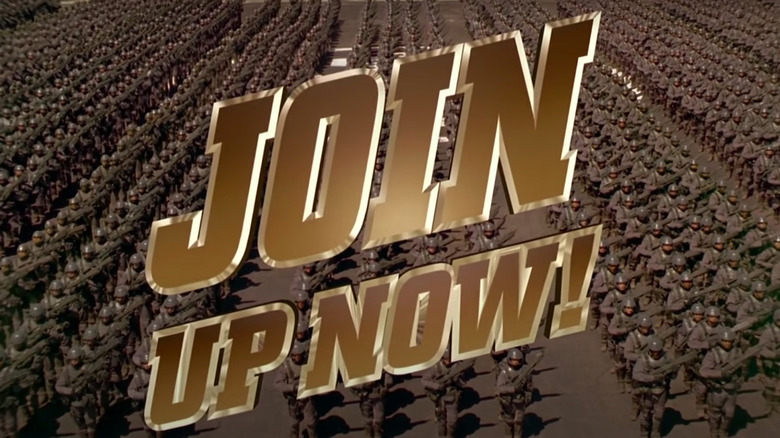
"Starship Troopers" opens with a propaganda newsreel that urges viewers to do their part for the United Citizen Federation and join the mobile infantry. This, the narrator says, will be their contribution to saving the world.
"Would you like to know more?" asks an intertitle before, seemingly without our volition, moving to a sequence informing us of the Bug menace and the threat it poses to humanity. We're told that they inhabit a planet called Klendathu, which has an "unlimited supply of bug meteorites" that are being fired toward Earth. "To ensure the safety of our solar system," declares the narrator, "Klendathu must be destroyed." How do the masses know that it is the Bug homeworld that's firing these meteors toward Earth? They don't, they just accept what the marketing tells them, and it further radicalizes young recruits such as Johnny Rico and Carmen Ibanez, who are the latest footsoldiers in the interminable battle against the Bugs.

In George Orwell's "Nineteen Eighty-Four," the totalitarian superstate Oceania is locked in perpetual war with its rivals Eurasia and Eastasia. To ask why Ingsoc, Oceania's evil government, commits itself to this violence risks detainment and death, so the masses give in to the hate and muster whatever quality of life they can.
"Starship Troopers" has little of the grit and misery found in Orwell's novel. We see only what this meta-propaganda film allows us to see, and it suggests that most of society's ills are external. They are the fault of the Arachnids. This is how the United Citizen Federation justifies its perpetual war, and Johnny Rico and his comrades accept it without question.
Are they right to trust a regime that is so clearly enamored of violence? Did 100,000 people really die in an hour during the invasion of Klendathu, or was this misinformation intended to radicalize troops at home and across the universe? These concerns are ancillary to the ultimate question: Why would the United Citizen Federation or any other government, real or fictional, want to commit itself to perpetual war? The shortest answer is control and money.
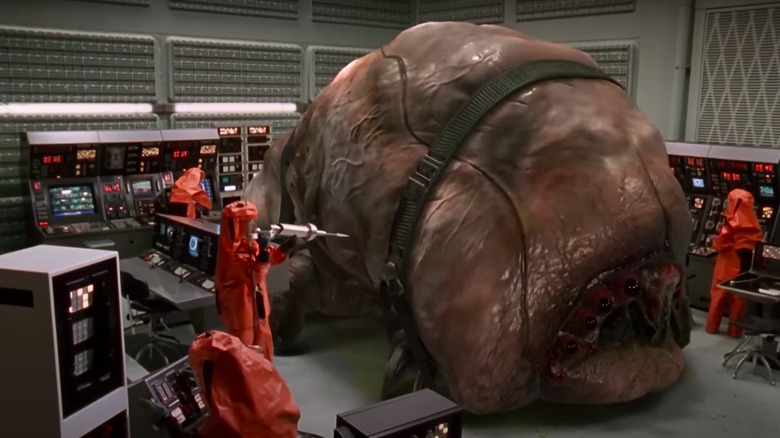
The Arachnids may appear bestial, but that does not mean they are without intelligence. On the contrary, the Arachnids are led by what the Federation calls "Brain Bugs," which can learn, strategize, and adapt. This knowledge affords little empathy for the Arachnids, though. No detailed explanation is given as to why the Bug is an enemy of the United Citizen Federation. We are told nothing of when and how the conflict started. Such information is vital to diplomacy, but the Federation doesn't know diplomacy, only war.
There is at least some respect for the Bug's capabilities. Early in the film, during a gory biology class, a lab-coated teacher expounds on the Arachnids' numerous superiorities, "it reproduces in vast numbers, has no ego, has no fear, doesn't know about death ... and so, is the perfect selfless member of society."
What the teacher observes in the Bug is what the United Citizen Federation wants in its people: an absence of individual thought combined with a fearless resolve to fight to the death.
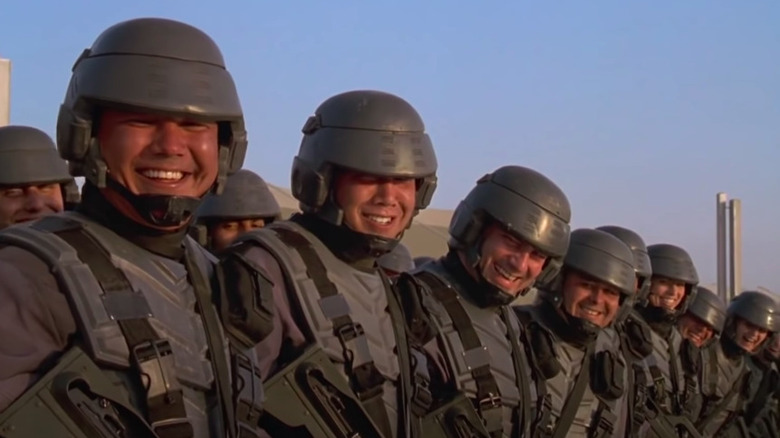
The Civil Rights Bill of 1866 declared that all people born on U.S. soil, with the exception of Native Americans, were citizens of the United States of America (this right was extended to Native Americans in the Indian Citizenship Act of 1924). However, the United Citizen Federation, which appears to be the United States' successor, does not subscribe to the notion of jus soli ("right of the soil"). Instead, the Federation enforces jus militaris or "right of the military," which means that only after military service will civilians be afforded citizenship and the right to vote, although the forces of democracy are likely ceremonial in the United Citizen Federation.
"What's the moral difference, if any, between a citizen and a civilian?" asks teacher Jean Rasczak (an ever-menacing Michael Ironside). Without hesitation, Johnny Rico answers, "A citizen accepts personal responsibility for the body politic and defends it with his life. A civilian does not." Rasczak is unimpressed by what he considers a fluent but glib response, and he asks Rico if he truly understands it, but the real question is whether Rasczak understands it, not Rico. Does Rasczak think that the United Citizen Federation is an open and transparent government? Does he think that the Federation is innocent and the Arachnids are wanton brutes? When he appears later in the film in combat gear, with a bionic arm, and an assault rifle, it appears the answer is a resounding "yes."
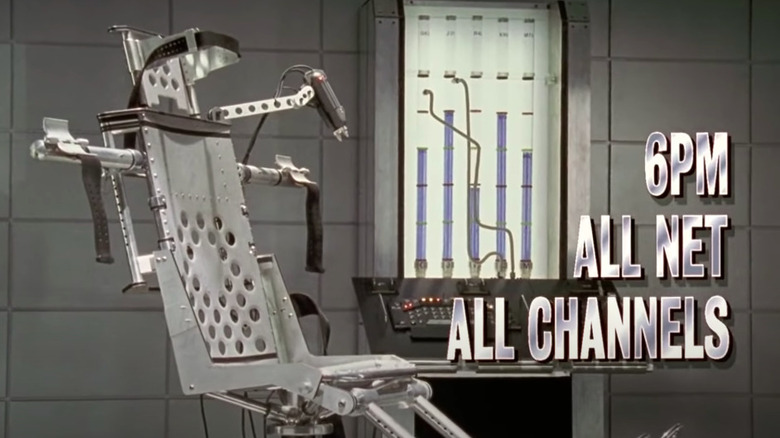
The U.S. military banned flogging in 1861, but the United Citizen Federation uses corporal punishment with a vengeance. When a man is shot dead in a training exercise on Johnny Rico's watch, the recruit receives 10 lashes. It's a rather lenient punishment in a society steered by violence, but that's because Rico is the all-American hero in this meta-propaganda film.
Ace Levy (Jake Busey) isn't so agreeable to the military leadership, especially Sgt. Zim (Clancy Brown) who disciplines Levy not with push-ups, solitary confinement, or formally sentenced lashing but by throwing a knife into the soldier's open hand, pinning it to a wall. This demonstrates that corporal punishment by spontaneous impalement is just a matter of managerial discretion.
A propaganda segment shows us the Federation's culture of capital punishment. An alleged murderer is paraded in court before the camera moves to the execution chamber, which appears to facilitate lethal injections. This may appear similar to the American 21st-century experience, but the devil is in the details. The narrator announces that the man was captured "this morning" and tried, convicted, and sentenced shortly thereafter, which amounts to borderline summary execution. You may miss that disturbing detail, but you won't miss the narrator's parting publicity, "Execution tonight at 6, all net, all channels."
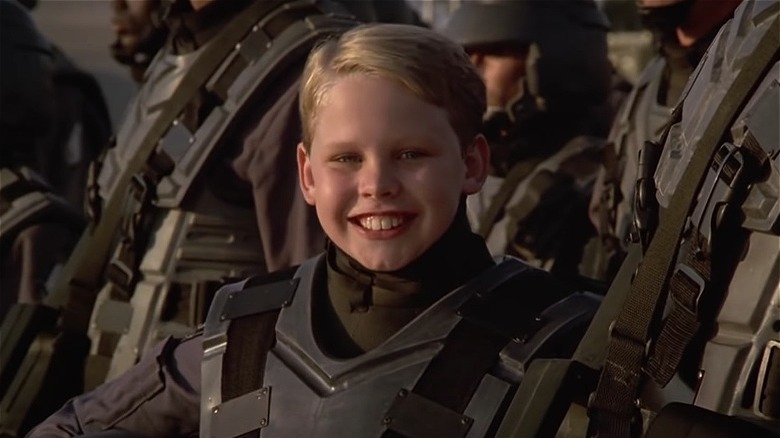
In the film's opening propaganda film, we see a mass of soldiers preaching about doing their part. Then, a child appears, helmet in hand, and says, "I'm doing my part, too!" The Federation uses this for comic effect, but there is a sinister agenda here, too. The Federation is in constant need of soldiers, and it knows that children's malleable minds are vital in securing this human stream. Children conditioned by militarism are far more likely to oblige notions of service and sacrifice — no matter the purpose.
Later propaganda targets children more directly, including one titled "A WORLD THAT WORK," which shows Federation soldiers handing their assault rifles to a group of children, who play and fight over the equipment while the soldiers snicker. Another scene, "DO YOUR PART," features neighborhood kids stomping on cockroaches, much to the maniacal glee of a nearby parent. We see the grim result of this brainwashing when Johnny Rico is given his own unit, the so-called "Rico's Roughnecks," which is no more than a band of kids sent to make up for the Federation's losses in the invasion of Klendathu.
There are numerous precedents of dictatorships targeting children. Nazi Germany's Hitler Youth and China's Red Guard recognized the power of young, radical minds, and North Korea's Socialist Patriotic Youth League still does.

The first view of civilian life we see is a classroom scene with Jean Rasczak lecturing on power and governance. "When you vote, you are exercising political authority, you are using force," Rasczak explains, "and force, my friends, is violence, the supreme authority from which all other authority is derived."
He's not wrong. This has been true of humanity since time immemorial. Today, the citizens of developed countries give the state a monopoly on violence in exchange for security. This unipolarity of violence is better than its opposites, bipolarity and multipolarity, which spell the end of order and nationhood and the beginning of chaos and civil war.
Not everyone is convinced, though. When Dizzy (Dina Meyer) suggests that "violence doesn't solve anything," Rasczak dismisses her point as wishful thinking and adds, "Naked force has solved more issues throughout history than any other factor." One could argue that Rasczak is a pragmatist, but his rhetoric goes beyond notions of realpolitik. Rasczak is a hardened Federation ideologue, and he toes the party line, which dictates that problems are to be solved with violence and violence alone.
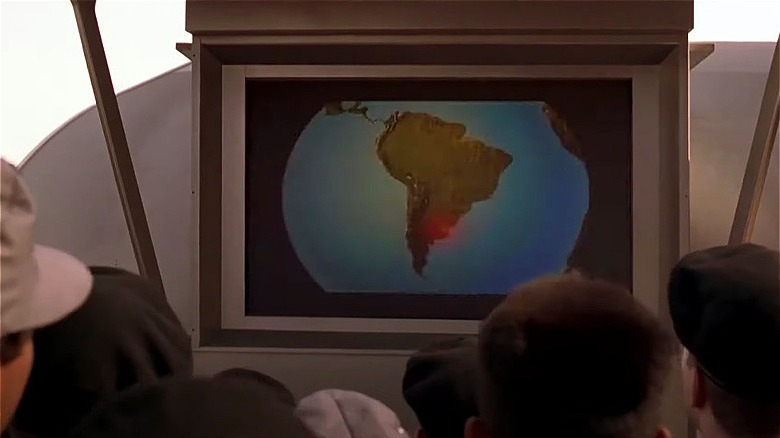
Johnny Rico and his peers appear to be English-speaking Americans, but they don't live within the borders of the 21st-century United States. They don't even live in North America. Instead, they live in Buenos Aires, the former capital of Argentina. Now, it's just another outpost of the Federation and its one-world government.
The Federation's vast size recalls the Oceania superstate of George Orwell's "Nineteen Eighty-Four." Oceania, like the Federation, covers Britain, the Americas, southern Africa, Australia, and New Zealand. "Starship Troopers" does not specify whether the Federation controls Africa or the Antipodes, but it does refer to a conference held in Geneva, which suggests significant control of Europe. It is likely that the United Citizen Federation has taken the world's great power centers and therefore has no Earth-bound military distractions. This is why they look to the universe for conquest and conflict, which are necessary for instilling fear, dimming critical thought, and maintaining the government's authority.
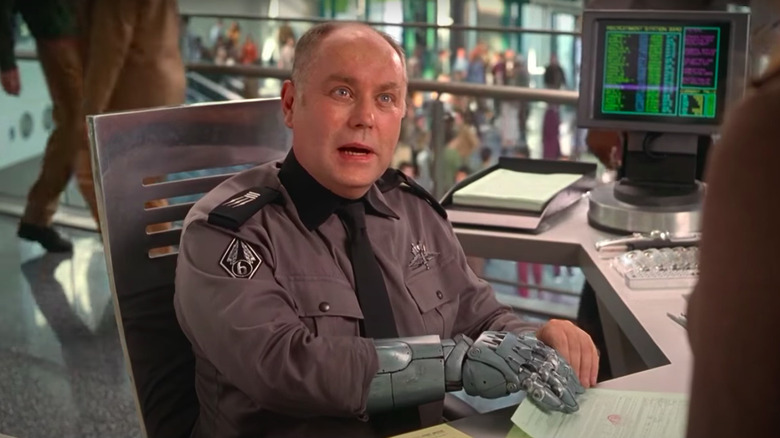
We see numerous soldiers killed in battle with the Arachnids, who use their giant legs and monstrous pincers to stab and tear their enemies apart. Gorier than that are the post-battle sequences in which dozens of people lay dead and horribly mutilated. It's a showcase for the practical effects that have become uncommon in contemporary mainstream cinema.
However, more disturbing than all the gore are the veterans back on Earth who must live with serious injuries. For example, Johnny Rico and Carmen Ibanez meet a recruiter with a bionic arm when they sign up for the military. "Fresh meat for the grinder, eh?" the veteran snarks before asking for their respective services. "Infantry, sir," replies Rico, to which the vet says proudly, "Good for you! Mobile infantry made me the man I am today." He then moves backward, revealing his seat to be a wheelchair and that he is also missing both legs. The double meaning here is clear and morbid.
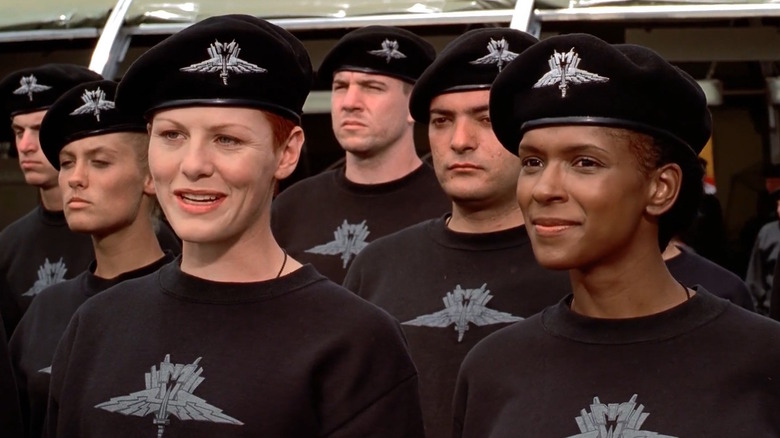
The Federation strives to control the past, present, and future of society, and an effective way of doing that is by controlling who can have children. This means that only those obviously committed to the regime are granted the necessary license. Dissenters will have their bloodlines cut short. How does one get a license? By serving, of course. It's not a prerequisite, it seems, but it certainly helps. We learn this during a gender-neutral shower scene (a favorite motif of director Paul Verhoeven) when a recruit says she joined the mobile infantry because she wants to have babies.
There is some degree of real-world precedent here. The People's Republic of China has never required a license for childbirth, but the regime did have its one-child policy from 1980 to 2016 (via Britannica). Forced sterilization has been mandated by governments across the world, too, including the United States, which sterilized some 70,000 people during the 20th century (via Berkeley).
Read this next: Sci-Fi Movies That Accurately Predicted The Future
The post The 10 Most Disturbing Details in Starship Troopers appeared first on /Film.

A third-party power management tool known as NVIDIA GPU Power Management enables lots of fine-tuning for GeForce GPUs in applications.
Modern games such as Cyberpunk 2077 require a lot of graphical prowess to run and can make cards such as the RTX 4090 sip over 450W when path tracing is enabled. However, there are also older games that don't require the extra power and all the extra performance is going to waste if the same cards are sipping over 400W power while producing frames beyond the monitor's refresh rates.
Some of the most common applications to limit power or locking framerate include MSI's Afterburner application (one of the top GPU applications available) or NVIDIA System Management Interface command lines (NVIDIA-SMI). The latter must be altered manually, but a new application allows users to control the power with an easy user interface called NVIDIA GPU Power Management.
This new tool is not a product of NVIDIA. It utilizes the NVIDIA GPU driver application and allows users to individually change each application's power management and memory settings so that all titles can be tailored for the user without needing to be in the game or application. This new graphical user interface (GUI) tool does the work of what would usually only be available through command lines.

The NVIDIA GPU Power Management application, created by developer Simon Macer, is available via Sourceforge. Macer has also created an AMD Radeon Setup Tool Project specifying the components and other options before installation.
The NVIDIA GPU Power Management tool offers users the ability to:
Since this is not an official NVIDIA application or tool, there are risks to downloading anything that alters the user's system. It is always a good option to measure any risks or issues with installing new software and do a system backup before installing software such as the NVIDIA GPU Power Management tool. The tool appears to be safe through virus detection software, but that does not mean the risk is eliminated. Always be cautious before installing software from 3rd party sources.
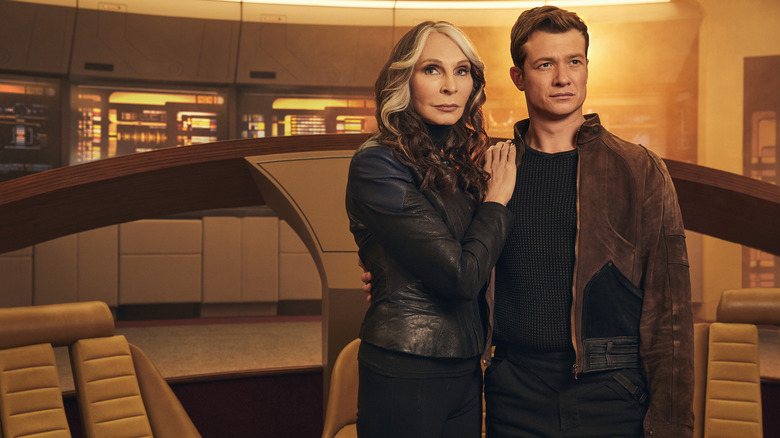
In the span between "Star Trek: Nemesis" in 2002 and the most recent season of "Star Trek: Picard," several dramatic events took place. It seems that Jean-Luc Picard (Patrick Stewart) and Dr. Beverly Crusher (Gates McFadden) finally took a chance on their will-they-won't-they flirtation that was never fully explored during their seven seasons together on "Star Trek: The Next Generation." About 20 years before the events of "Picard," the couple took a chance and had a single night of wild passion. Immediately afterward, however, they both decided that it had always been a bad idea. A love affair, a marriage, or any kind of relationship likely wouldn't work. Perhaps predictably, the night of passion begat a child.
Jean-Luc, however, had such a busy and dangerous job — captaining a starship constantly puts one's life at risk and takes up every waking hour — that Dr. Crusher chose to never tell him about their child. She gave birth to her son away from Jean-Luc, named him Jack after her late first husband, and the two of them began a new life together. By the events of "Picard," Jack (Ed Speleers) has been living with Dr. Crusher aboard a very tiny ship called the Elios, secretly smuggling medical supplies to non-Federation worlds desperately in need of them. They had both become proficient in sweet-talking criminals and would offer them weapons in exchange for access to areas where people may be sick or injured.
Jack was in his early 20s at this point, and Picard never knew about him. Did Beverly make the right choice?
In a recent interview with Variety, McFadden talked about Dr. Crusher's motivations for keeping Jack a secret, and said she understood how either choice could be supported or rejected.
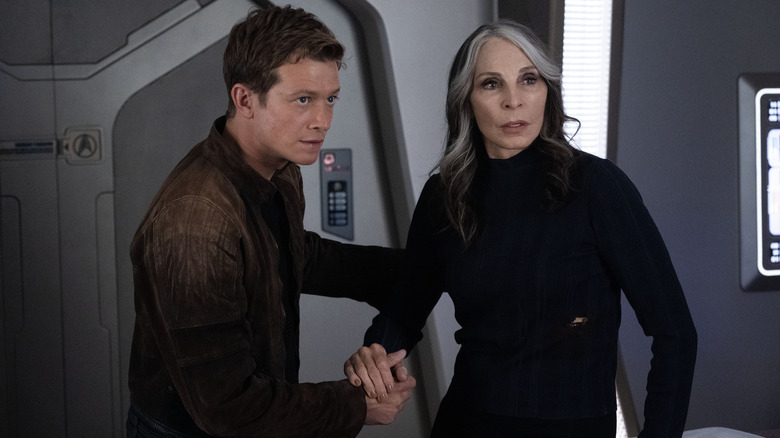
One of Dr. Crusher's most notable features on "Star Trek: The Next Generation" was her unflappable ethics. She lived by a very strict moral code, and wouldn't deviate even in extreme situations. In the episode "The High Ground" (January 29, 1990), Dr. Crusher was kidnapped by terrorists who insisted she treat their internal injuries sustained from using contraband transporters. She cures them, naturally, but yells repeatedly that what her kidnappers are doing is wholly wrong. She begins to sympathize with them by the end, but only to understand their grievances. She still objects entirely to their means, as well as to Starfleet's combat-forward solutions.
Following her own path has always been of paramount importance to the character. When McFadden was asked about Dr. Crusher's resolve and individuality, particularly as it pertains to Jack and her decision to keep his existence away from Picard, she said the following:
"It's interesting because she didn't choose to have an abortion. She really wanted to be a mother. And if you've just been recently listening to Picard's deepest thoughts — 'no, I would never want a baby, absolutely no, no, no' — I think you have to base it on what she knew then. And I think she hopes that later the child would reunite with Picard, and it's a shock when her son doesn't want to. And perhaps she had an instinct, when the child was crying all the time at night, that this child needed protection, and was perhaps a little different."
Whether or not a viewer agrees is, of course, a different matter.
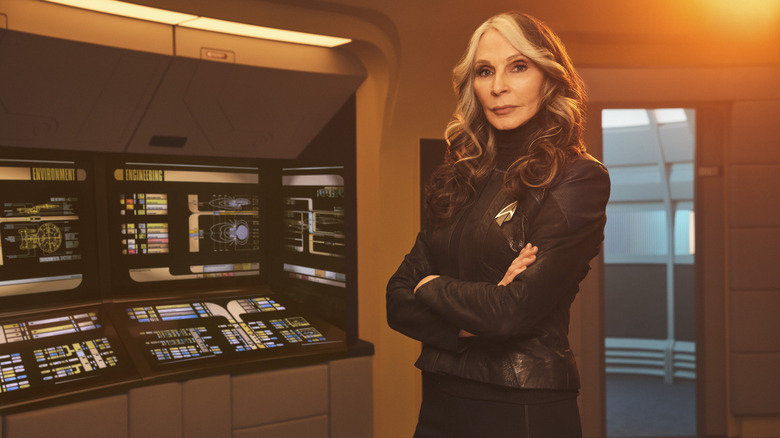
The trick to playing a morally resolute character is that one has to wholly understand and support their decisions, even if you disagree with them. McFadden seems to have encountered critics who felt that Dr. Crusher's decision to keep Jack hidden from his biological father was a bad one. Surely Jean-Luc Picard should be given the opportunity to address his fatherhood on his own terms. McFadden, of course, had to see things from Dr. Crusher's perspective. She acknowledged the clash, saying:
"Obviously, there's going to be people who disagree with [her decision]; I understand that. I just feel also people should then try to focus on maybe the good of why that happened."
Given the wild world of "Star Trek," and the various extreme situations that Jean-Luc Picard often found himself embroiled in, Dr. Crusher's decision makes perfect sense. As a parent, she was able to bond with Jack on her own terms and didn't have to concern herself with the stress of her child's father being in constant danger. Additionally, Picard was typically very aloof. As seen in "Star Trek: Picard," a romantic relationship between Jean-Luc and Beverly was always destined to fall apart, so one can see quite easily why she made the decisions she did.
McFadden has said she would like to continue playing the version of Dr. Crusher that the showrunners of "Picard" had invented. Given her own exciting life and resolve "Star Trek: Blazin' Bev" would certainly be a sight to behold.
Read this next: The Main Star Trek Captains Ranked Worst To Best
The post Star Trek's Gates McFadden Understands The Mixed Reaction To Keeping Jack A Secret From Picard appeared first on /Film.
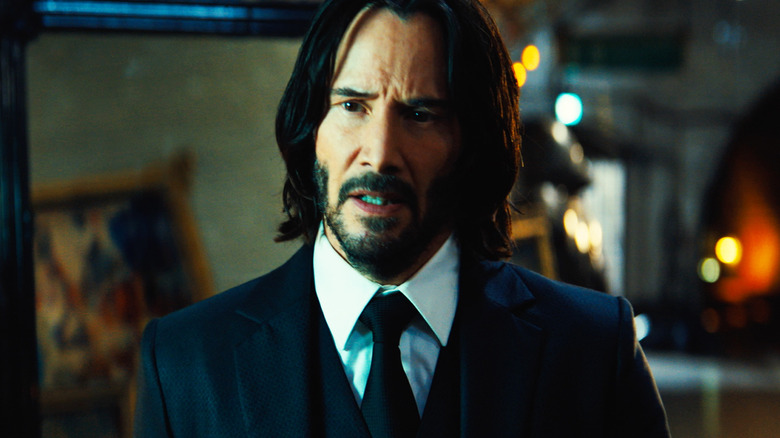
With the latest entry in the "John Wick" franchise, director Chad Stahelski pushed himself and his team beyond anything they'd done before. "John Wick: Chapter 4" is three hours long and packed with more elaborate action than any of the previous three entries in the saga -- which is saying something.
This latest entry seemingly lurched from one set-piece to another, providing ever more inventive ways to punish its protagonist and showcase some stylish combat in the process. There was the infamous back-breaking staircase scene in Paris, which saw John Wick battle his way to the top of a staircase leading to the Sacré-Cœr, only to fall all the way back down and have to start over. That followed another memorable set-piece that involved John Wick fighting waves of attackers amidst speeding traffic at the Arc de Triomphe -- an outlandish scene that even prompted Keanu Reeves to wonder if they went too far with the car stunts.
But going too far is the name of the game. People come to John Wick for its bombastic, over-the-top action, and this latest installment certainly provides it. In fact, in its efforts to push action choreography beyond where it's previously gone, you might say the franchise has taken action as an art form to deadly serious levels. But if you ask Stahelski himself, it's also all a bit of a joke.
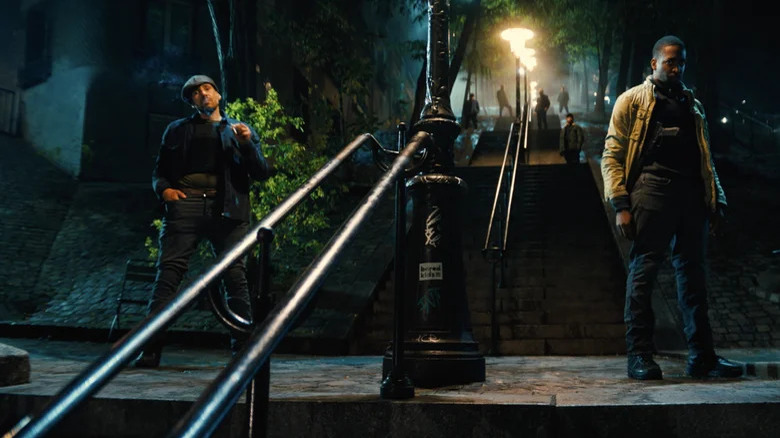
Speaking to RogerEbert.com, Stahelski elaborated on his conversations with Lionsgate about the film's epic runtime, explaining that he didn't have to fight "about the runtime" but rather justify, "why the runtime." As the director sees it, making such a long movie is only justifiable if you're able to keep an audience engaged throughout, and depending on who you ask, he and his team may or may not have achieved that with their latest effort. In fact, /Film's own Witney Seibold argues that "John Wick: Chapter 4" is proof that action movies can have too much action.
But Stahelski saved his most interesting comments for last. The filmmaker said:
"The whole gag of the movie is to have longer than long fight scenes—we're making fun of ourselves. We're making fun of the genre. We don't want to take them too seriously, we're trying to make this fun. The whole gag is excess. That's the whole moral of the story, the theme of this John Wick mythology."
Sure, there's always been a slight tongue-in-cheek aspect to the "John Wick" movies. They are, as Stahelski says, an exercise in excess. But there's something odd about Stahelski's comments here, in that it's never seemed as though the "John Wick" films are explicitly making fun of the action genre. Quite the opposite, in fact.
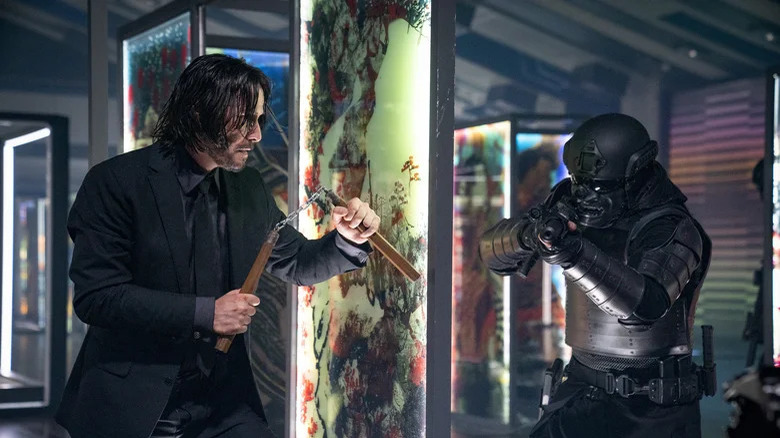
Chad Stahelski, Keanu Reeves, and his stunt coordinators have taken the action in their films seriously enough to spend time crafting their own gun-fu combat style, drawing from legends of the genre such as director John Woo and treating action itself with reverence and respect. Their style has influenced almost every other action movie released in recent years, and feels less like the result of a group of people "making fun of the genre" and more like the result of people taking it seriously enough to forgo character development and story in favor of putting action front and center.
If anything, the John Wick franchise stands as an argument for non-stop action being enough to carry a film. Stahelski, himself a former stunt performer and choreographer who doubled for Reeves in the "Matrix" movies, basically crafted a four-movie love letter to action itself. That's why I don't entirely buy that the whole thing was just an exercise in making fun of the action genre.
That said, there is an obvious absurdity to the whole franchise. After shooting wrapped on "John Wick: Chapter 4," Keanu Reeves gifted the stuntmen t-shirts tallying how many times they had each individually been dispatched by John Wick. And over the course of four films, Wick has racked up 439 kills, which is an insane body count when you consider these movies are supposed to take place over the course of just six months. In that sense, it feels more like Stahelski and co. are at times having fun with the genre rather than making fun of it.
Read this next: 12 Awesome Action Movies That Never Got Sequels
The post John Wick's Long Fight Scenes Are Actually Intended to Make Fun of the Action Genre appeared first on /Film.
Read more of this story at Slashdot.
The IBM PCjr. had many faults, one of which were the compromises IBM imposed on the machine to limit its PC compatibility. By the time the PCjr. was released and in people's homes and offices, there was over two years of software developed with only the IBM PC and IBM PC/XT in mind. For a too-brief period of time, PCjr. compatibility was an important focus, especially as some companies updated their software to become PCjr. compatibile. Then once the PCjr. was discontinued, PCjr. compatibility pretty much fell by the waist-side not too long afterward. In this article we will identify the issues which held the PCjr. back and what needs to be done to show that a piece of software is truly PCjr. compatible.
Read more »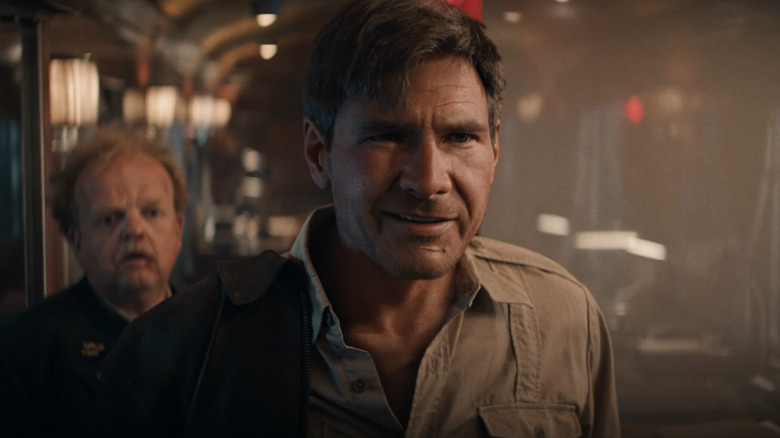
De-aging tech has received its share of criticism, and rightly so. In our nostalgia-mad monoculture, being able to digitally rewind the physical effects of time seems like a neat trick that can, and kind of has, only been used as a gimmick. In recent years we've seen de-aging tech creep further into movie-making and so far it's yet to really prove its worth. There was the time Corridor Crew did a better job than Lucasfilm of deep-faking young Luke Skywalker. Then Martin Scorsese tried de-aging Al Pacino, Robert DeNiro, and Joe Pesci for "The Irishman" — a fascinating project that ultimately ended up feeling a bit uncanny, especially when DeNiro performed a fight scene as a 30-something version of himself who moved with all the aggression and vigor of a semi-conscious toddler waking up from a nap.
Other attempts at using de-aging tech as a storytelling device have come from Marvel, whose VFX department seemingly added one of those selfie beauty filters to Robert Downey Jr. for a brief flashback in "Captain America: Civil War." But for every ungodly android-esque nightmare vision, there are examples of the tech working quite well. That's especially true when it's used sparingly, like in the final act of "Blade Runner 2049" when Sean Young's Rachael is briefly resurrected as a clone.
And it seems, even though it's mostly set in 1969, the upcoming "Indiana Jones and the Dial of Destiny" is using young Indy flashbacks that, if the trailers are anything to go by, make similarly effective use of de-aging technology. This must have been a surreal experience for Harrison Ford, who evidently feels himself to still be the lovable young rogue that first won our hearts back in 1981's "Raiders of the Lost Ark."
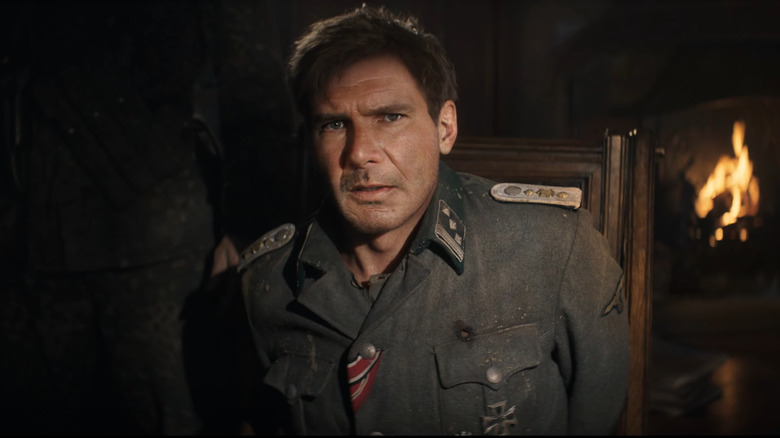
We've seen impressive de-aging shots in "Indiana Jones and the Dial of Destiny" thanks to the film's trailers, which showcase the 1944 flashbacks and the film's approximation of a young Indiana Jones. Harrison Ford, 80, is playing a 70-year-old version of Indy in the film's main 1969 setting. But it seems Lucasfilm has improved its de-aging tech drastically, which might have something to do with the fact they hired that YouTuber that did a better job than them of deepfaking back in 2021. The de-aged shots in "Dial of Destiny" are essentially advanced deepfakes, with Lucasfilm using their extensive archive of Ford's image to recreate his younger likeness.
Ford has spoken about how the de-aging shots in "Dial of Destiny" are different, in that they're all based on these historical images of his face which are superimposed onto his actual performance. Now, in a Total Film interview, the actor revealed that he finds the de-aging tech to be, "an intriguing, useful, and extremely sophisticated story device." That might have to do with the fact that, according to Ford, he still sees himself as a younger man. Asked whether he recognizes his older self in the de-aged shots, he said, "Yeah. In fact, when I look in the mirror, I still see that guy with brown hair."
Considering Harrison Ford hasn't shied away from doing his own stunts in "Dial of Destiny," while also throwing himself into some intense horse-riding action as part of his "1923" TV series, it's not all that surprising the 80-year-old still sees himself as a younger man. De-aging technology might have a surreal aspect to it, but it seems Ford found some kind of affirmation in seeing his performance as an octogenarian rendered in a younger-looking body.
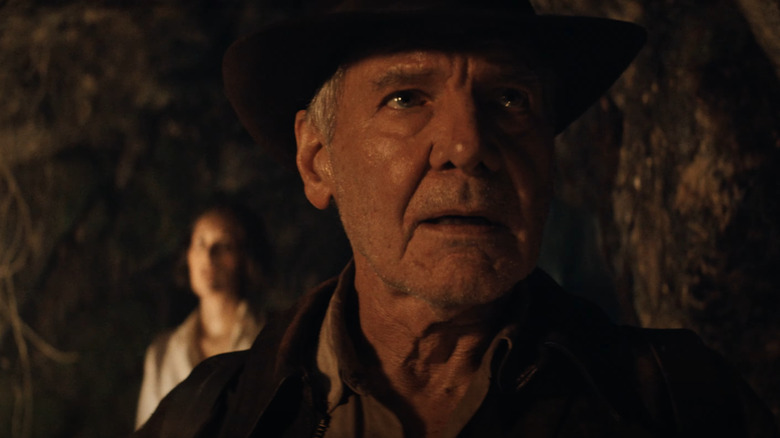
In the Total Film article, "Dial of Destiny" director James Mangold commented on Harrison Ford being an "incredibly gifted and agile" leading man. This bodes well, as while the de-aging certainly looks impressive thus far, its success will come down to whether Ford managed to sell his body movements enough to maintain the illusion while filming the scenes in question.
According to Mangold, those scenes comprise a, "25-minute opening extravaganza," designed to, "give the audience a full-bodied taste of what they missed so much" — that being young Indiana Jones. Until the film actually arrives we'll have to wait to see whether these VFX-assisted scenes actually do serve the story or whether they are, like so many other de-aging attempts, gimmicky nostalgia plays.
In general, de-aging tech is exciting in that it could allow older actors to demonstrate more of their abilities by playing younger versions of themselves and designing complex performances to meet that challenge. Think Matthew McConaughey in "True Detective" season 1. The Oscar winner played detective Rustin Cohle across a 17-year span, developing a detailed performance that made subtle changes to his character's body movements and vocal cadence depending on which version of Cohle he was portraying. Season 3 saw Mahershala Ali achieve a similar feat, but these were both younger actors playing older parts. If de-aging tech can reach a point where it's convincing enough to not disturb us all with nightmarish visions of half-human grotesques, then we could, theoretically be able to witness more of these types of singular performances from older actors. And perhaps "Dial of Destiny" will be the turning point.
"Indiana Jones and the Dial of Destiny" is due in theaters on June 30, 2023.
Read this next: The 18 Best Action Movie Actors Ranked
The post Harrison Ford Still Sees 'That Guy With Brown Hair' When He Looks In The Mirror appeared first on /Film.